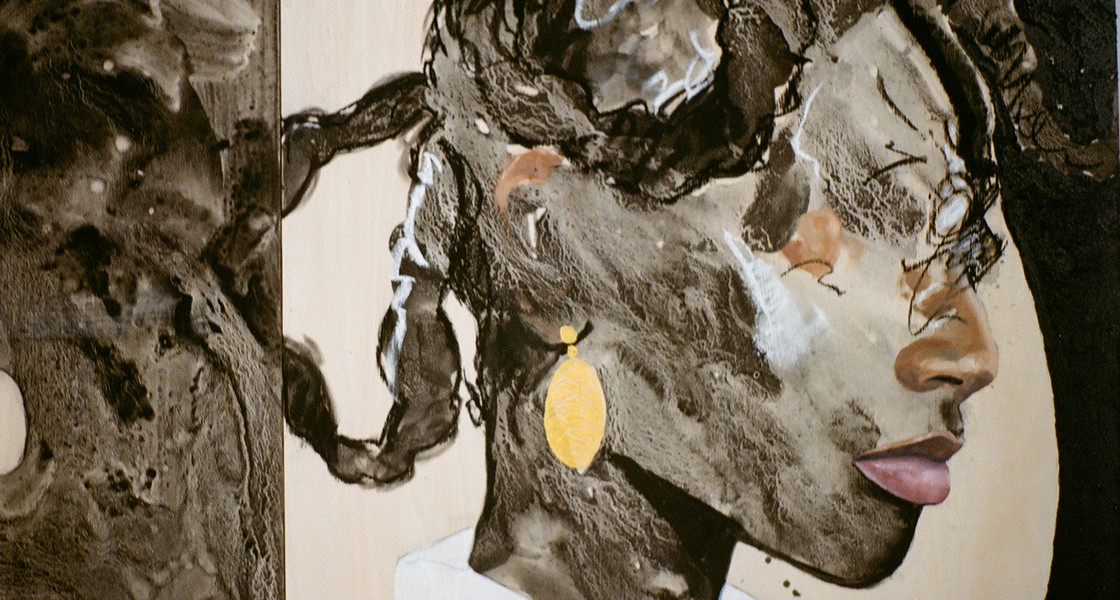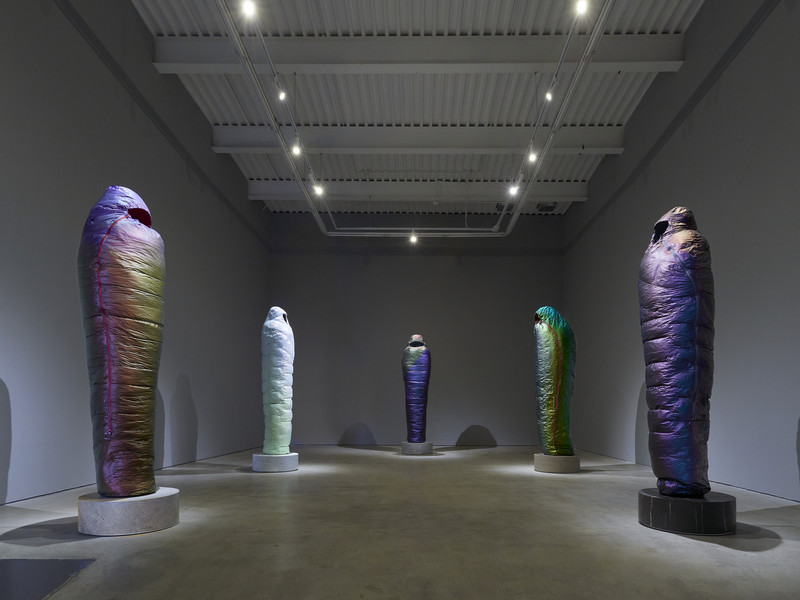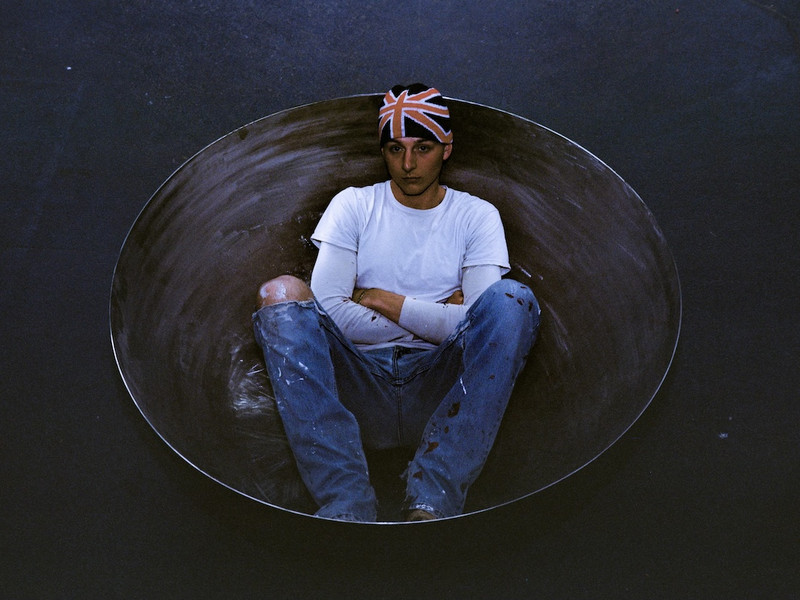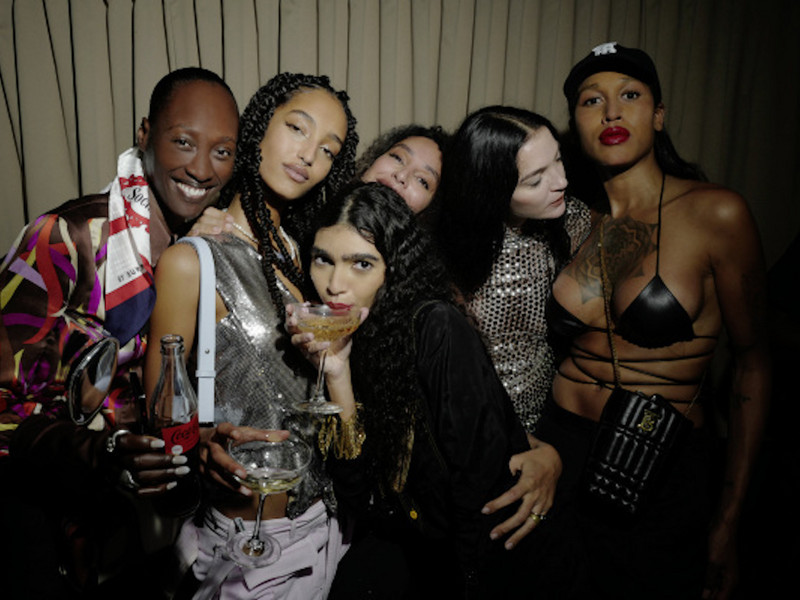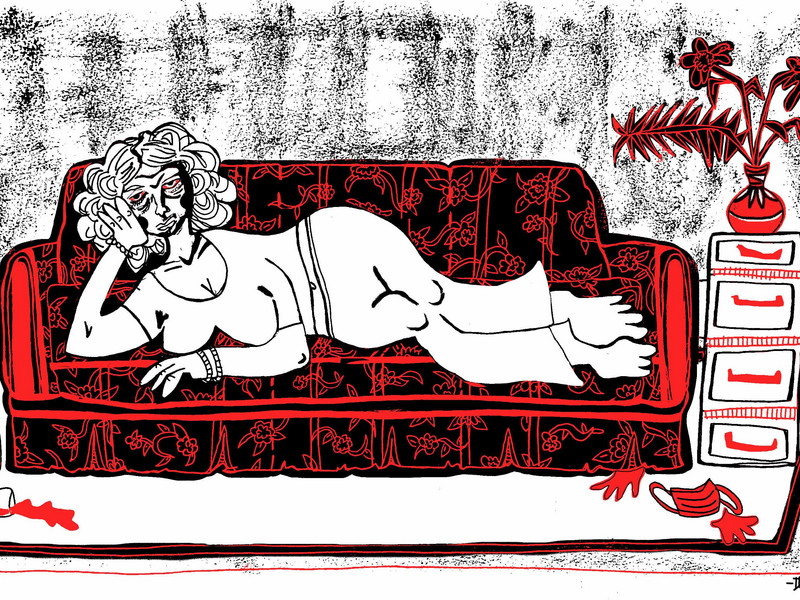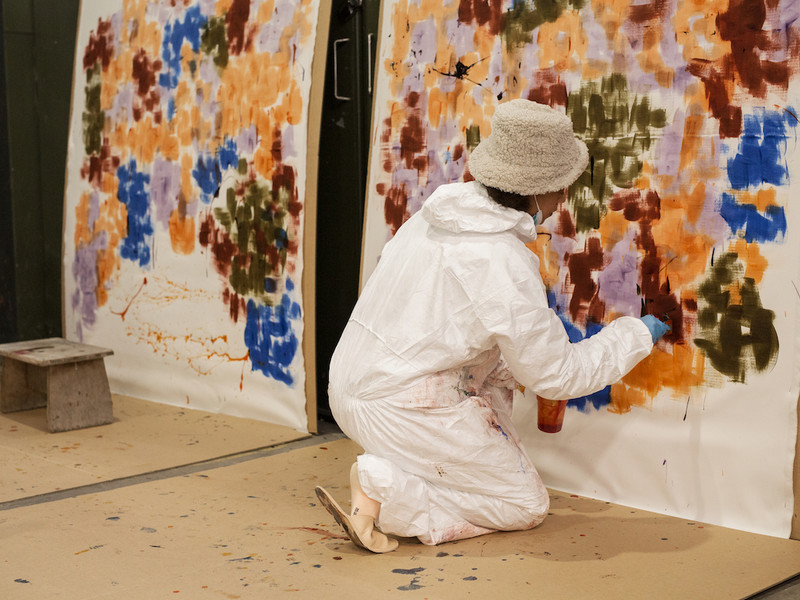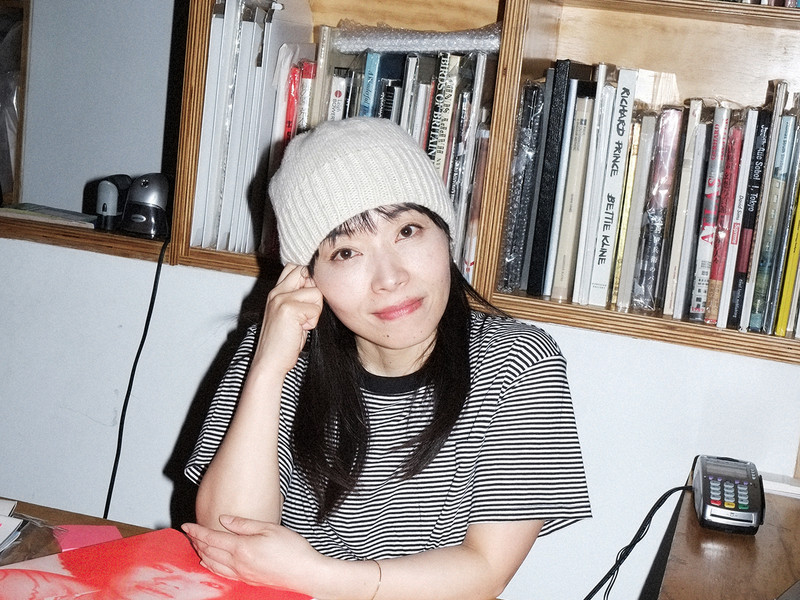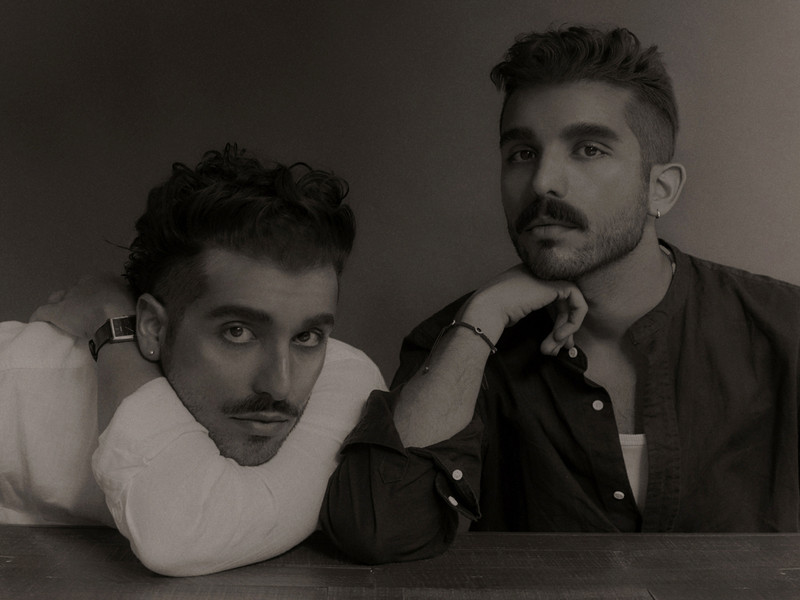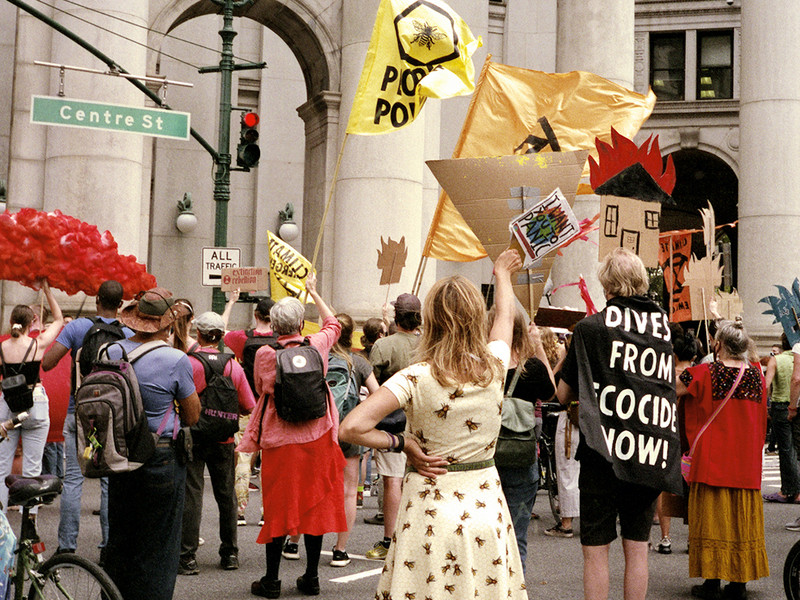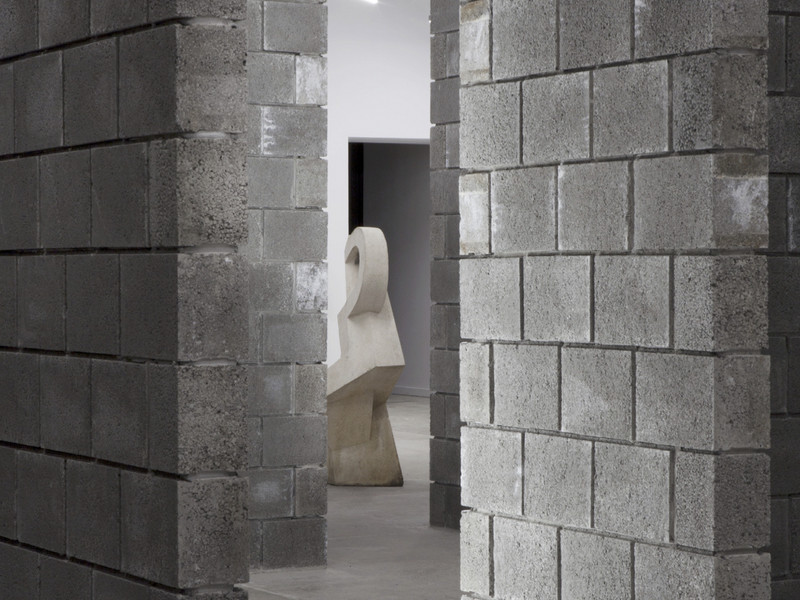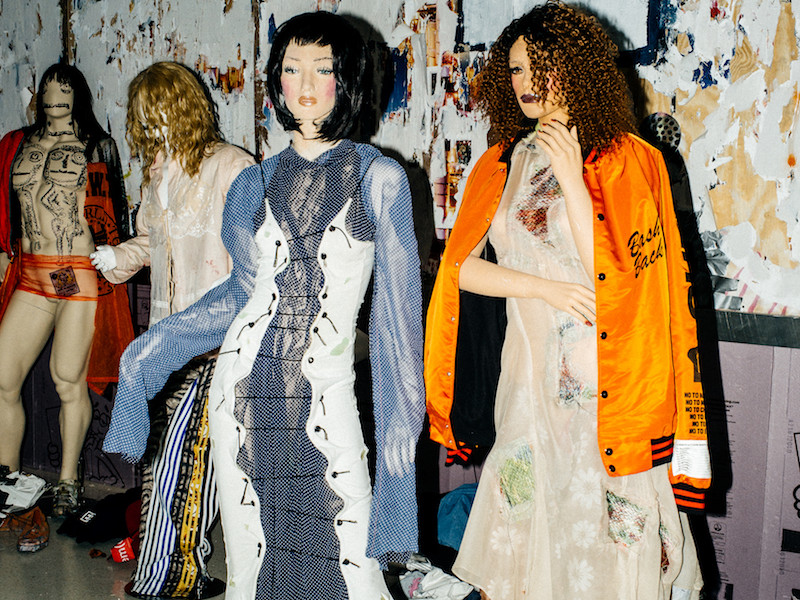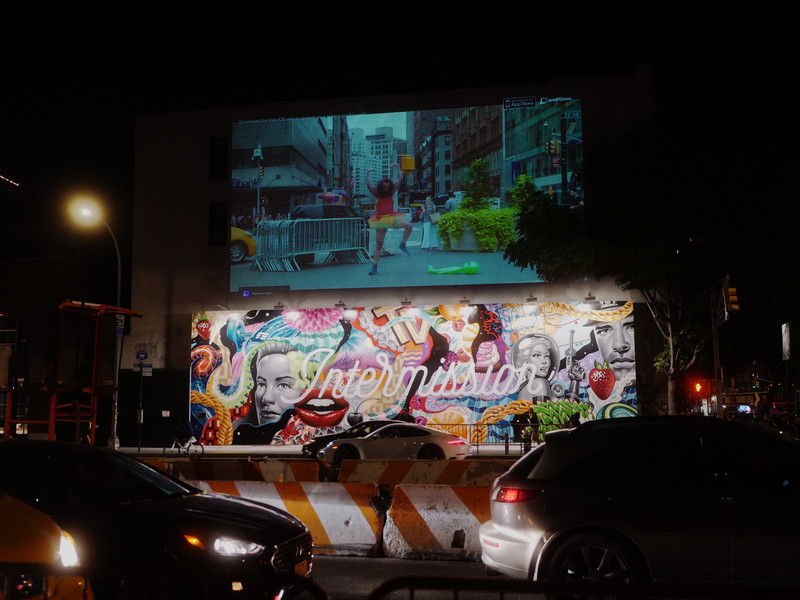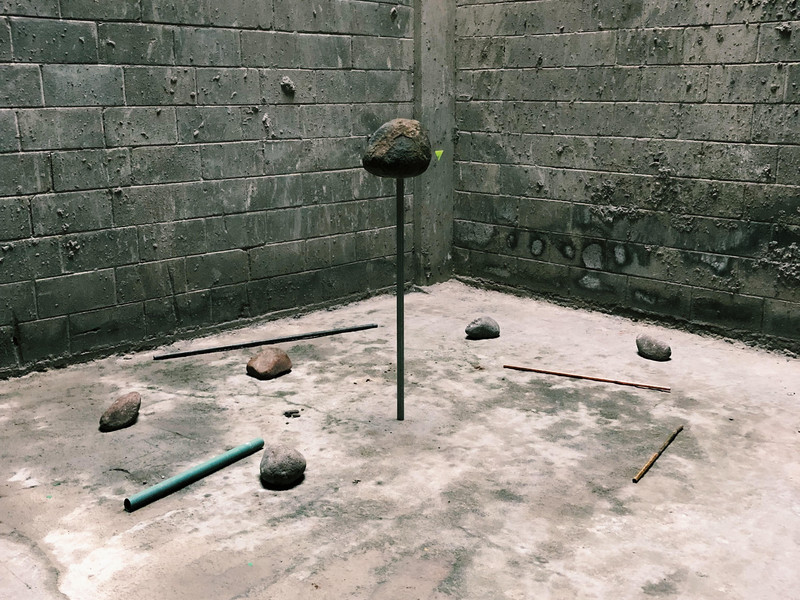Khari Turner: “Breathing Water to Air”
Born in Milwaukee, Wisconsin, Khari presents his work with nods to his childhood around water. Although working many different jobs growing up, the artist always came back to making art. He enrolled at Austin Peay State University in Tennessee, where he received his BFA in studio art, finally making his way to Columbia in New York, where he is on track to getting his MFA. Khari Turner’s artwork celebrates Black Americans, and he chooses to honor them as survivors. He explains, “My paintings and drawings combine abstraction with realistic renderings of Black noses and lips to rejuvenate the relationship of my history to my ancestor’s history with water.” Khari Turner’s work is breathtaking, symbolic, and precisely what we need today.
Read our exclusive interview below.
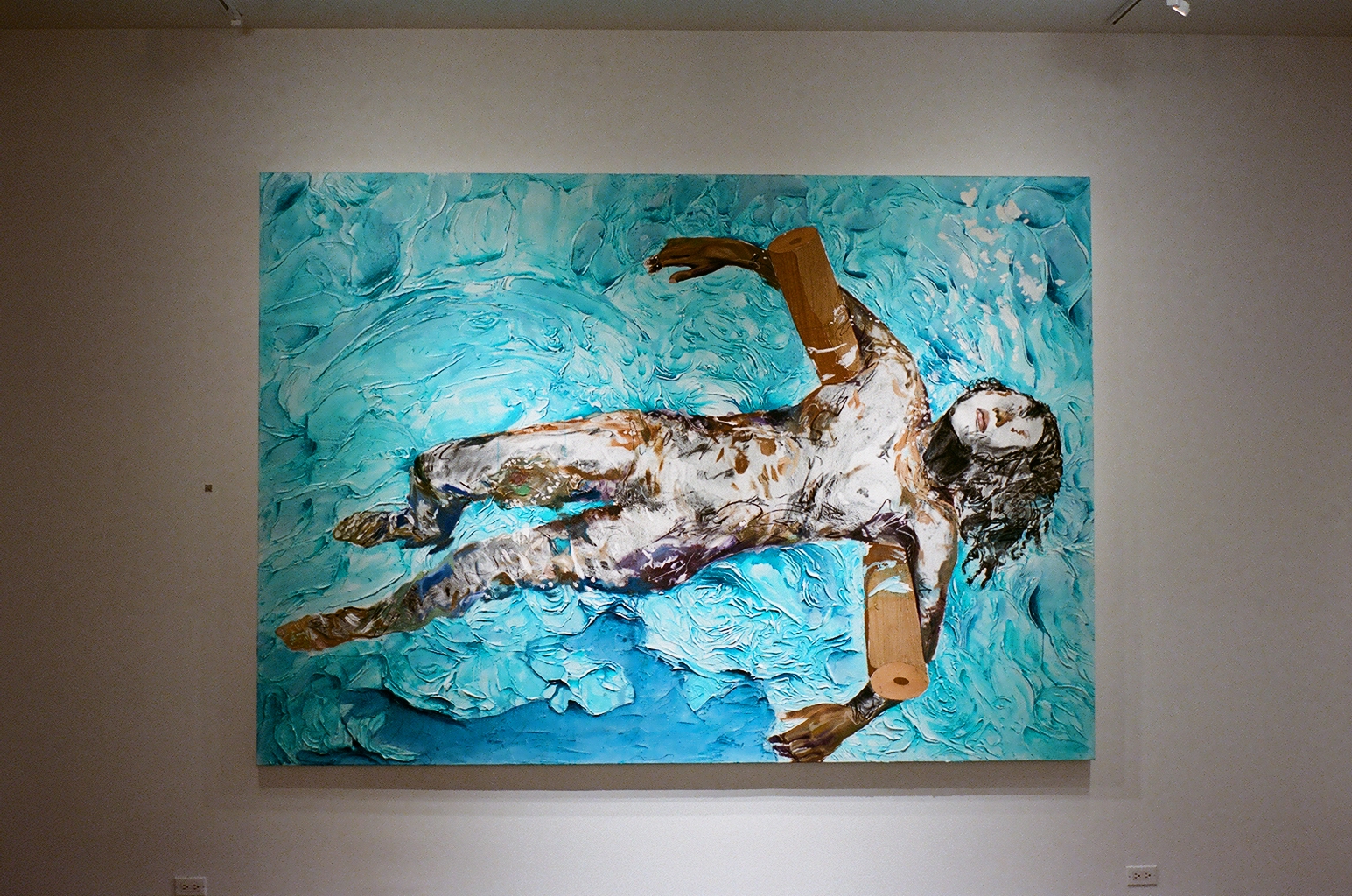
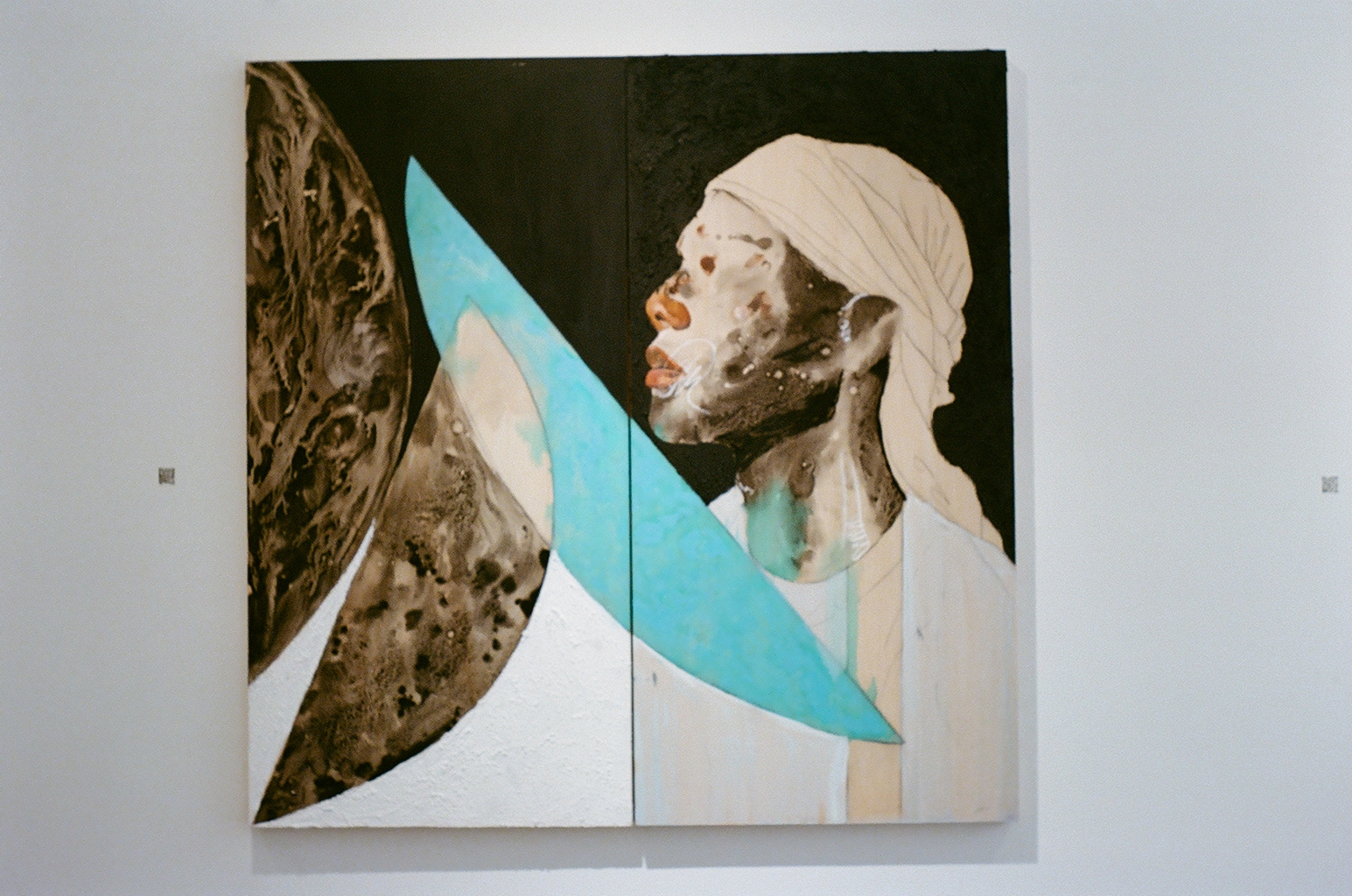
This is a podcast for office magazine, I’m Lance de los Reyes, interviewing great artist, Khari Turner. Congratulations on your solo exhibition. You just graduated with a master's degree in art.
From Columbia.
From Columbia painting. Were there any art teachers, painting teachers that had a good inspiration or influence on your work?
Yeah, there were a bunch of different teachers. A lot of them had their own influence on me one way or another. Some notable names would be like Pamela Sneed, Gregory Amenoff, Sable Elyes Smith and a bunch of other names.
Congratulations on receiving a master's degree. That's a big accomplishment. Do you think that getting an education in fine art and in painting is an attribute to your painting career?
Yeah, I feel like education is one of those things where essentially you can do it by yourself, but having the help of other people creates a quickness to the gap of learning. So I can definitely learn everything that I learned by myself, but it would have taken me to find that information, get to where it's at, understanding what I'm looking at through me rereading it, whereas educations makes it easier. I skip all of those steps by being able to have a conversation and be given the information that I already don't know.
How much of awareness towards the contemporary fine art world and what creates the idea of a great artist as far as the marketing or the galleries or the collectors? Was that at all taught to you in school?
No, not really essentially what the problem is that with education right now COVID changed everything. So I went into my first semester regularly, like a regular semester would be where I'd go to classes, talk about art, critiques, whatnot, but then my second semester, and then following through my final year, it was all online and that changes everything. Talking about getting an art degree and not being able to see the art in person or even experience having critiques with people, looking at the art in person. So everything changed. I think that what they did teach me was a lot of ideas that I wasn't about in terms of like what I was already doing in my own space, cause everybody had their own bubble. So I was literally just sitting in my room, thinking all the time and you know, you can only think one way usually unless somebody throws in something else. They were really good at throwing in different ideas, and that was everybody in the program. There were people who were also reaching out to me through social media and whatnot. And so it became one of those things where I did not get taught, you know, business or any of those aspects. But I started picking up on it the more I kept having conversations with people.
At what point in your education did it click and did you think that you were going to become a respected and recognized artist right out of the gates of receiving a master's degree or achieving an education in fine art?
Uh, I don't think it ever clicked.
Has it click now?
I don't even think its clicked now.
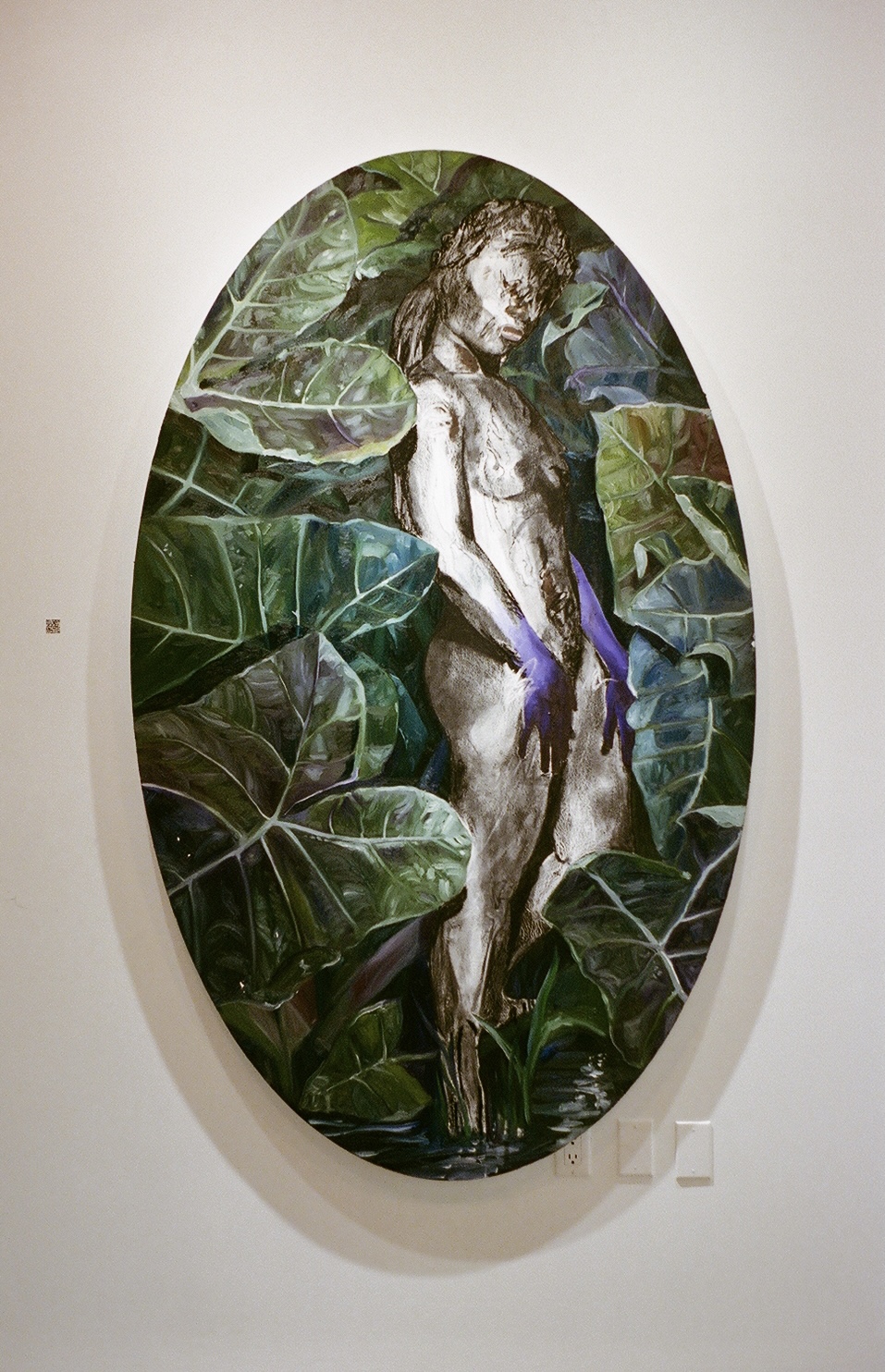
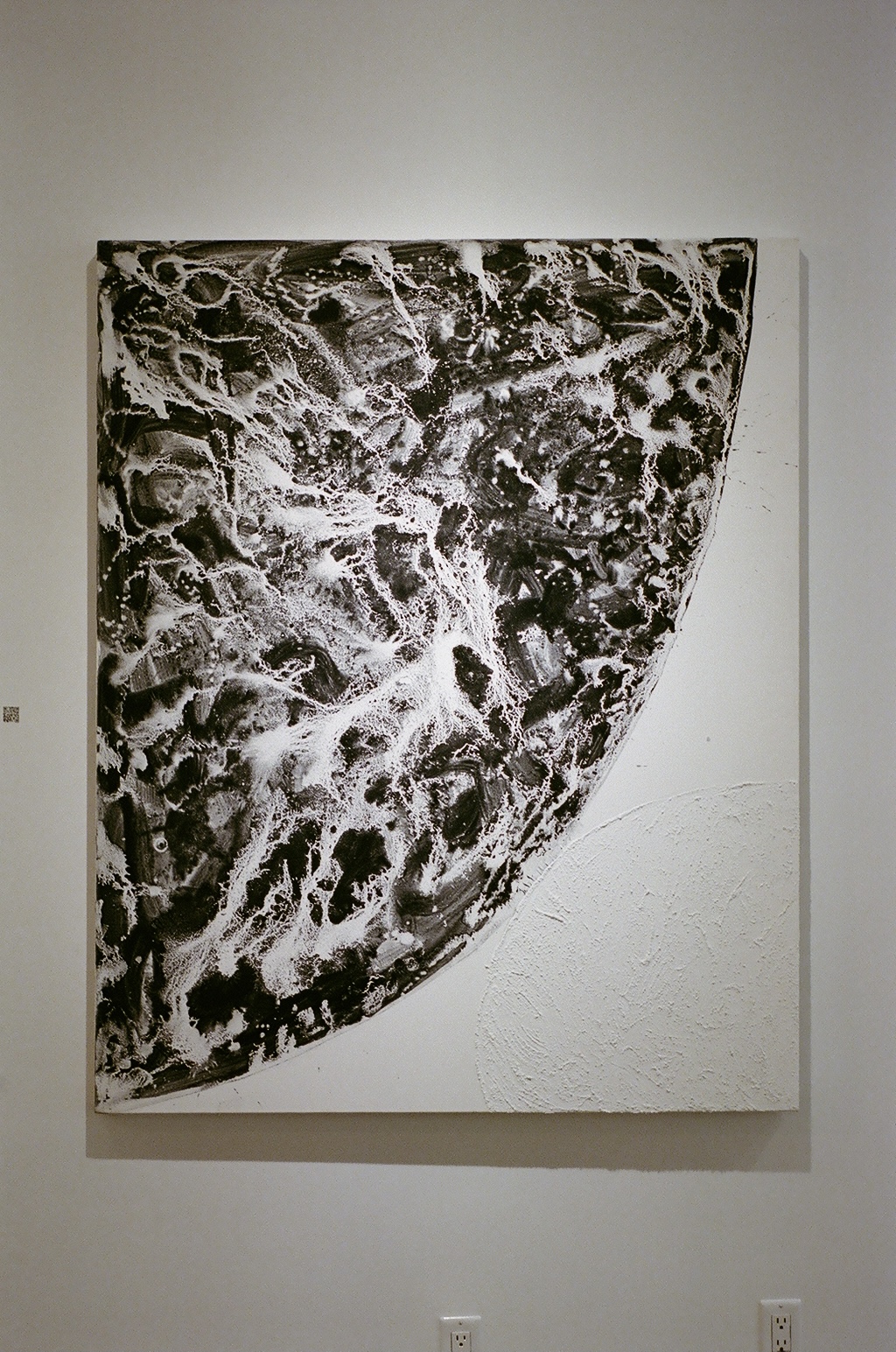
Its definitely clicking now though, right?
I feel like it's definitely there. I think there's still some critiques. I got to get to a point where I'm like, oh, this is it, you know. I know I'm on the incline, and I know there's a lot of great comments towards my art. Even with this, I enjoy this show, but I know for a fact that this is another step in becoming what I really want to be. So I don’t think I ever got to there. I think there's definitely been steps all along the way where knew that I was going to break into something and these new steps would start
Yeah. With the work a residency in July was definitely the biggest one.
That’s when I first added the ocean water to the work and then that changed everything. Another one was in December of 2019, kind of right in the end of finishing up my first semester of grad school. I had a studio visit with Tschabalala Self, and she came in and just talked to me about my work. Right afterwards I took what she said and really started churning something out. I started working with this like black and white scale and that happened in the work. That took me to another step, so you know, I just had little steps along the way that I saw and I was like, okay, this is going to lead to something. Sometimes I don't know what it is and then something happens and that turns into something else.
So as a, kind of display, and a showing of this body of work, there's a lot of really powerful little paintings happening in the big paintings. Like the boy floating in the water, the abstraction reminds me of Joan Mitchell. I'm also in awe with the amount of different tempos and ways that you move the paint. So are all those just coming instinctually or are you conscious of and inspired by other great artists or recognized artists or past masters?
It's a little bit of both. Essentially, coming into school and coming to New York specifically opened up my eyes to whatever the possibility of art was. I came from Milwaukee, Wisconsin, from an urban area, from the hood, but then I went straight to Tennessee, which was great, but I was in a small town in Tennessee where it's kind of like the same thing. It was a bubble where it was just the educational system and me taking art classes and then explaining art and how to make art, but not explaining what the grand scale art can be. So essentially when I came here I really experienced the different atmosphere from just like looking at art in classrooms and maybe small galleries that are like in Tennessee, to these huge galleries and big large spaces and these giant museums. So I was already interested in all these different techniques, but what really got me was being in front of some of these paintings I had seen in my projectors or in the classroom on these big monitors.
I really got into abstract expressionism and abstract minimalist. I'm like really into a Frank Stella, Helen Frankenthaler, you know all these people who are working in these different ways of looking at art and color, but also, thinking about the use of material. You know, how is the application happening? And so when I first got to grad school I knew I wasn't strong in my painting. I knew that everything was too calculated and so I tried to like make boxes and color, in those boxes in a certain way. In my drawings, I just let loose, I could free flow and write however I wanted to, because I knew the extension of how much I can draw versus how much I couldn't draw and how to get my message across, but I didn't have that in painting.
My first semester, all I did was just paint multiple little 16 by 20 inch canvases, trying to get confident in color until I got to a point where I was like, well, why am I not drawing on my paintings? If I'm so strong and drawing, why aren't I doing both? And so essentially I added drawings into my paintings, then improved my paintings because then I started realizing like the same way I’m marketing while I'm drawing should be the same way that I'm painting. So not everything is subconscious in a way where I know exactly what I want to feel when I'm making the mark.
I don't actually think that I even care what it looks like, but as long as I know that the feeling is put into it, then it'll come out fine.
Yeah. What's beautiful about your paintings is that first, you just see how beautiful it is, and then I think the eye goes to the different textures and the different marks, and then you think about what the painting actually is, and then you think about the narrative. So I think that, I think the confidence and the work is really apparent. And I think that maybe school just helped you relearn your toolbox as a great artist.
Yeah. The great thing about Columbia is that they, they give you a bunch of different tools and then let you free roam or whatever that is. And that works for me, but it might not work for everybody, but essentially that's what they did. They gave me the space. They gave me these teachers who knew a lot of information and they gave me like people coming into my studio, but essentially I had to come up with whatever—
Your equation.
Exactly. And so a lot of that was me in the studio, just thinking and doing, and then somebody would come in and throw a wrench into it and it made me rethink it again. That was just keeping me going, because then I'd get to a point where I knew I had something outside, but it's missing something. And they wouldn't usually give it to me snd tell me what's missing, but they would get so close to what I'm thinking about that I figured out what I was missing. In the same way that all the marks now, you know, have drawings in them. When I was first doing this, I was doing, just drawing on the side, on one side of my room and then painting on the other side of my room and I would do drawings and then like, look at them as I'm doing my paintings, thinking like, I need to try to work it on the same thing.
People kept asking me, if I don't, you know, do something else with the drawings or do this with the drawings. And eventually I got to the point where I was like, why am I not merging them. So it was one of those things where they got me just close enough that I just figured it out.
So let me ask you the question. Do you think that being in school was it competitive with other artists? When I was in school there were little groups of artists did you have an appreciation or respect for the dialogue between the artists or was it kind of competitive?
Nah, I think Columbia is one of those situations where they say it's an open discipline. So all the disciplines mix and they all did critiques of each other and did all types of stuff. So you're going to get something from everybody that's different. So I might have a sound art person in there with a sculptor who was also in there with a painter. We were all like bouncing off of each other. A good thing about it is, getting into the school super competitive, but once you're in the school—
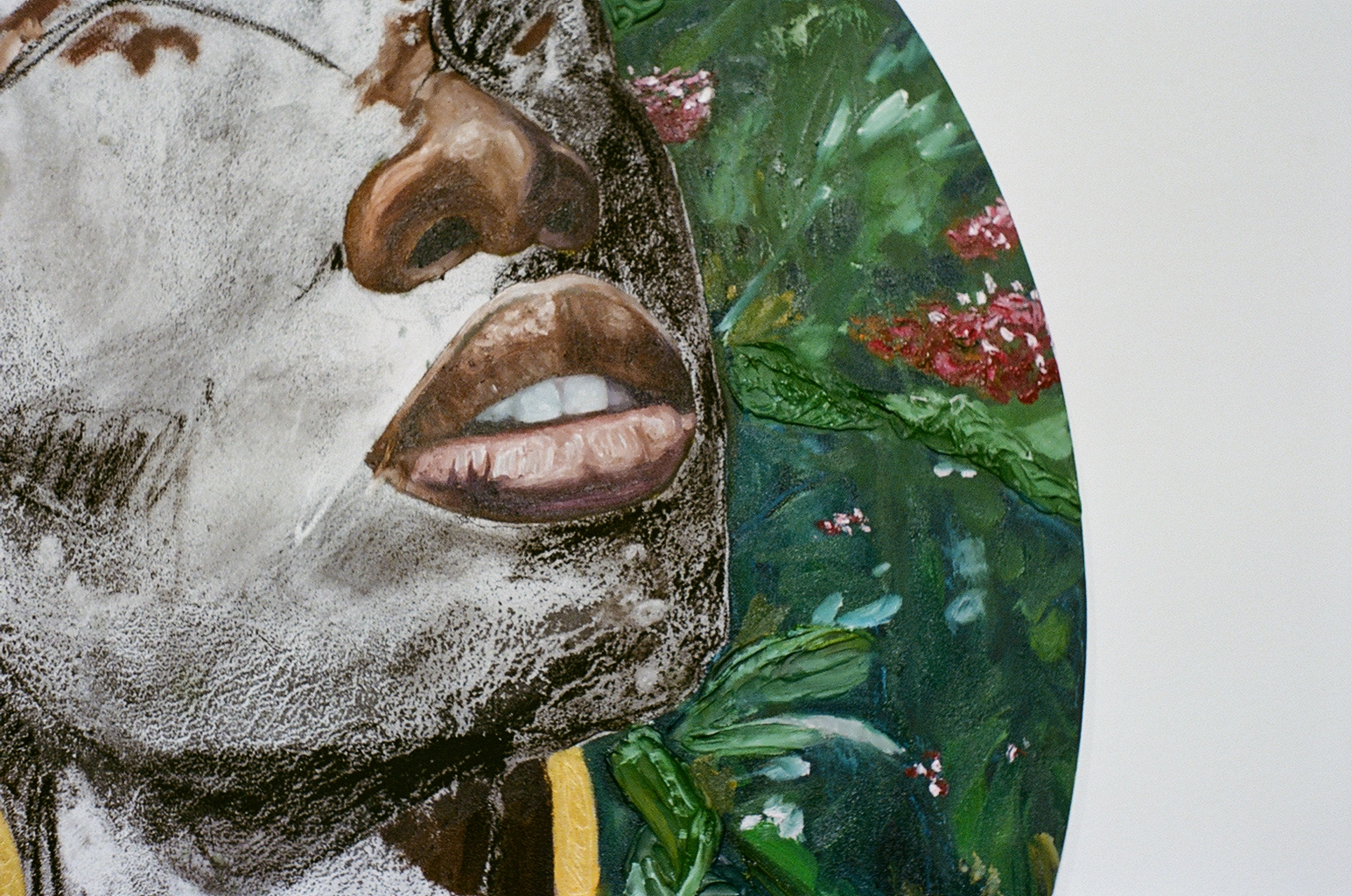
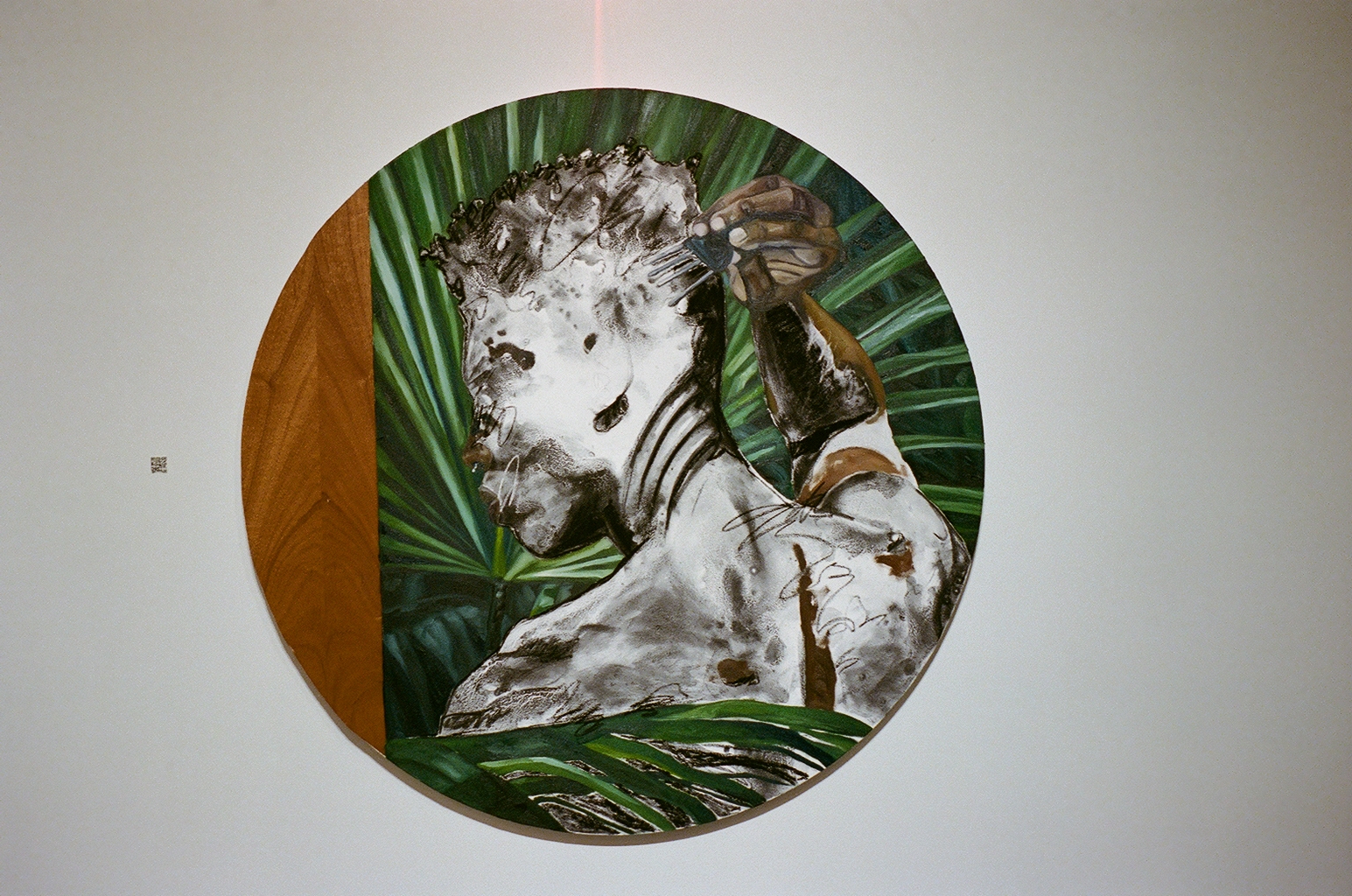
Well, that's an accomplishment in itself just getting in.
Yeah. So once everybody was in and it was like, it was really chill, it was really friendly and it was a lot of family. You know, we used to have like get togethers and stuff with each other. When we would have visiting artists because, you know, they wanted to create an atmosphere where all of us can talk to each other without that awkwardness and give when you just meet somebody. Again until COVID happened and then it got, it got weird, like really interesting, but also not as good as it could have been, obviously. And really think that the group is still the group, but a lot of us are still individuals at the end of the day. Like we probably could have had a lot more collaborations and stuff like that.
Maybe the collaboration is it's ongoing.
Yeah. That's the case for sure.
You guys will all be monitoring each other's success.
Yeah. I'm hoping for that for sure. And a lot of us have been in groups shows with each other and have spread out all over the place, so it's been good. But yeah, I think that its not competitive once you're in it, but it's super competitive as you're trying to go for it.
I also saw, when your family came to visit Kehinde Wiley came in. Does the idea of having someone successful, like Kehinde Wiley, does that give you something to look forward to as far as just even him, you know, another contemporary, great artist recognizing your work and seeing the potential? And the kind of trajectory and how much attention and recognition that you're accomplishing.
Yeah. That was, that was wild. I don't even know what the, I don't even have - I don't have artsy words for the way that I reacted to that. Cause it was like, oh my God, it was like I was standing there, and he came in and I heard somebody talking behind me and I look, I see a dog and then I seen his face and it was one of those things where you know somebody's face immediately and you know you've seen it. And I didn't have words. I was so surprised. It was like a bomb. He messaged me before on Instagram and so I knew he knew of my work and I knew he was interested in it for sure. But I haven't talked to him since it happened that last July when I first started actually starting to put ocean water into this work, when he got in contact with me. So him to see the work where it's at now is so crazy because I feel like I definitely evolved a lot.
So during COVID, the riots, BLM, people being quarantined and the amount of obvious attention that African-Americans, however you're politically correct to say and then also with Instagram. I think that the way I see it is that people see Instagram and then everyone wants to be a painter, right, and everyone thinks that they're a painter. Obviously painting chose you, can we agree on that?
Yeah, for sure.
I think that people can choose to be a painter and that the idea of being a great artist actually finds them and then the human being relearns it. You are definitely in my mind, and in a lot of people's mind, a great idea, as far as becoming a great artist, to pay attention to. But what do you think about the tempo or the temperature of what's going on in the fine art world? How much of that influences what you do in your personal craft? For example, Is Instagram like a big thing for you where you're interested in seeing what everyone else is doing? Or are you very much into you and your own contributions and obligations to being a great artist?
Both. So, and what I mean by that is, I know for a fact I care about what I'm doing on my platform, and the second part of that and what I'm interested in, is not the people who are already kind of making their way, in one way or another, either way, but the young people are looking at me as an example. So essentially, I'll try to reach out— and I’ll also mention the fact that a lot of these young people do see painting as like the end all be all to the way that they can create art.
Do you think that a lot of people look at being an artist or the idea of being an artist as this thing where, because they're painting that it deserves to be on a wall and then they automatically, because they see the success of amazing artists like Kehinde Wiley or Joe Bradley or Eddie Martinez or Rita Ackerman or Julian Schnabel, Rashid Johnson, and they like the success of it instead of actually investing in what it is that they have to offer in painting. Do you notice that?
Well yeah and I talk to young people about that because the thing about it is, is a lot of them want to be artists in one way or another. However, the artists that are successful in essentially what success means to them, is making money and not working as a barista while making art, or doing some other random job while making art is the people who are painting in some way or another. So they're like, well if I want to not do something and I want to make art, I see that this is working so I’ll do that instead of allowing themselves to see other artists or sculptors, installation, all these other people that they’re jus not seeing. I'm also telling these kids to look at art magazines. None of them are really reading art history like that and may only know art through one terminal or another. So it becomes a question making sure that they see art and other variations, as well as making sure that they're seeing art from 360 degrees. Looking at art mags, critics, also words from the actual artists, are they looking at YouTube videos? Are they looking at documentaries about these things? And a lot of them are not. Essentially, they're looking at Instagram. That's why there's a lot of kids who do digital art, because they're like, oh yeah, I can do it this way because this is what the top Instagram people are doing.
That's what to me makes painting, and especially your paintings, very special. And actually, I feel like us being surrounded by your paintings is like I'm looking at an artifact. I feel like I'm looking at these snippets of this great process that you're going to have. And I feel like the narrative of the paintings is very mysterious, but they're very bold and strong. Can we talk about the way that the white is in the figure? Because after I saw this opening, I was so inspired to research the history of voodoo. And about how people that aren't necessarily educated or know much about it, see it as kind of this evil thing, but it's kind of the total opposite. So I think that there is some sort of connection with your ancestry and your lineage being African-American and actually showing this kind of really sacred side of it through the body language. Can you tell me why some of the eyes are morphed out and why the nose is peaking and the lips are peaking, but there seems like there's this powder that's on them. Is there some sort of symbolism for you there?
Yeah. So it's a lot of different things. Essentially, all of the works are made with water in one way or another and so thinking about the ocean as the beginning. But also like birth. thinking about how much water affects us.
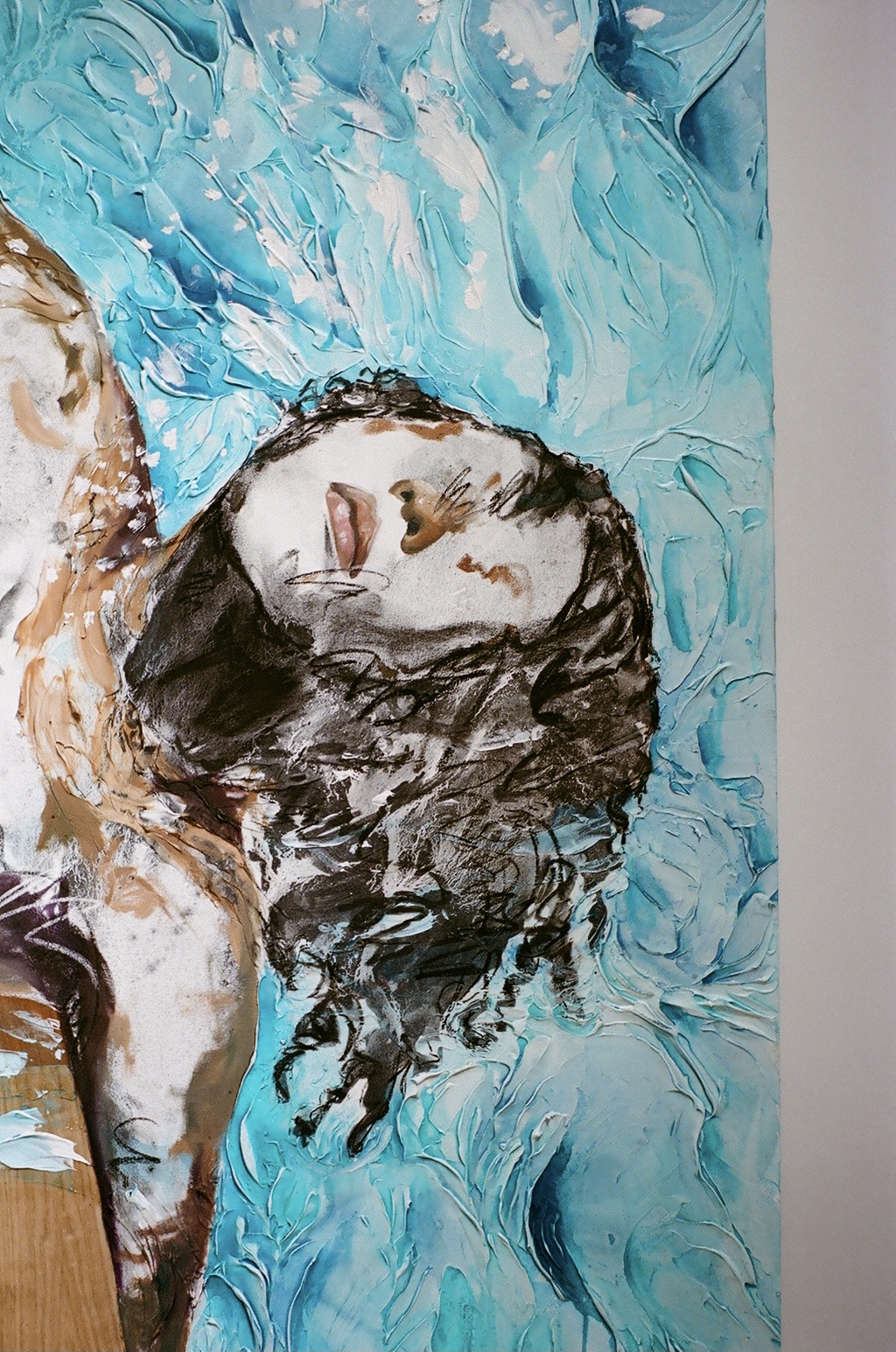
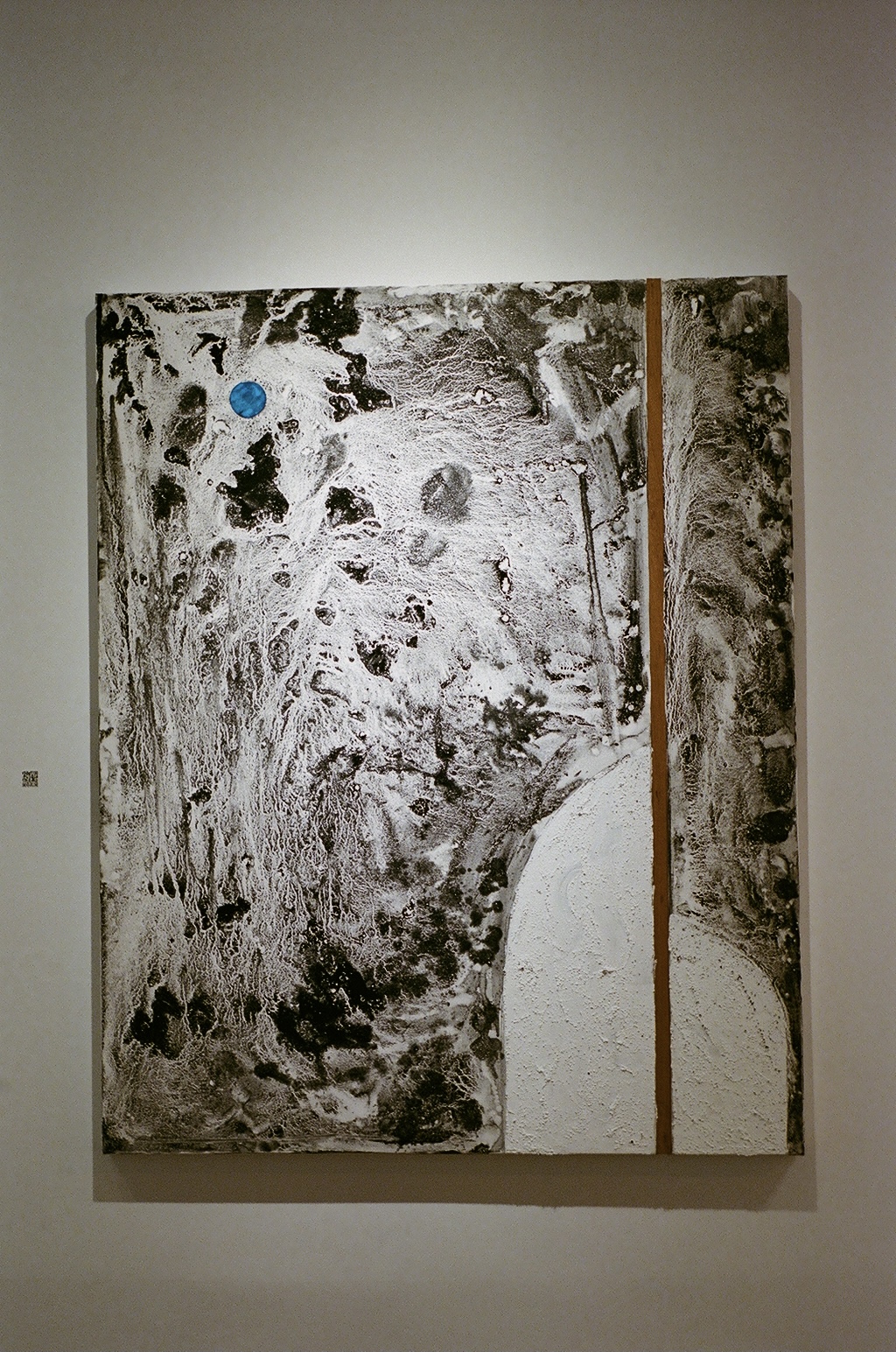
And when a woman breaks water, she gives birth. A friend of mine, she’s more of an outsider artist, said that the paintings are masculine, but saw a very strong balance of feminism and masculinity in the body language, in the lines, in the color. So do you think as an artist you are like subconsciously coming to a balance in a resolved painting with the idea of balancing out masculinity and femininity?
Yeah. For sure. And if you actually pay attention to the amount of feminine-versus-masculine-presenting characteristics of some of these people, they should be balanced. It should be somewhere around seven to six paintings of both of those features.
Then let's talk about the balance in this body of work, as there's the figurative and then the minimal painting with the little circles in them. What's happening in that painting? Is that your contribution of minimalism? Is the whole show a narrative between figurative and abstract?
It's definitely abstract painting, but what the show is more like is a concentration on the use of the material and what that material does. There's multiple ways to read the spirit that comes with using this material than just me putting it inside a person.
Yeah. Because we talked about the material and texture of the ceilings. We both lived in homes with with that rough ceiling. And then the wood?
Yeah. Well, with the wood I was also thinking about using ocean water and thinking about that journey, again, these boats essentially that’s also the shape. I was like thinking about Ellsworth Kelly a lot. So as Frank Stella.
As someone that is destined to be a very strong force in the contributions of being a recognized painter, especially coming out of college and receiving a master's degree, it seems like you are saying that like you have multiple ideas for multiple bodies of work. That’s what I'm seeing. Is that right?
Yeah.
With the responsibility of being an artist that's being collected and there's a waiting list for your paintings; you see that as a privilege, right?
For a fact.
And you see that as a privilege to always be showing your utmost discipline and respect for being a great artist.
Very much so.
As far as the idea of Khari Turner, and the amount of people interested in your work, could you say that you're going to be doing this no matter how much abundance you make, the work's only going to get stronger?
Oh, for a fact. I think that's regardless of the fact, I'm an artist no matter what, if I didn't have these collectors, I wouldn't have these collectors, but I'm still going to be making paintings. During the quarantine, all I did was paint every single day. And I didn’t care who was looking at the paintings.
You also got a bachelor's degree in painting. So the quarantine just presented itself while you were getting your master's degree?
So it was one of those things where I couldn't allow anything or any outside force to interfere in me thinking about the work, because I had this day and sit with it in my space and in my living, as I woke up to it with sleep with it. So it changed a little, well, a lot. So regardless of any of that, I'm still an artist in the whole heart, so I'm going to keep making work and I only can get better if I continue to create my art.
There's kind of this conversation with the amount of attention that African-American artists are getting that there's a lot of portraits coming and it looks like a lot of textiles coming, but clearly in these figures, there's very confident, abstract mark making and color combinations. In each painting I just see a lot of confidence and I really enjoy thinking about you and the moment, like when you make one of these marks and you knew that it was done. Very much like a Cy Twombly or De Kooning, or Joe Bradley. So when you're in your studio and you're creating these paintings, you're obviously by yourself. But is there music playing or lectures playing or are there any kind of podcasts on? What’s it like being in a studio with Khari Turner by himself?
Yeah. It's a mix. I'm listening to reggaeton, African music, hip hop.
Let me ask you this, what famous pop star, in kind of like the attitude would you say that you have. Would you say that there's more of a Kanye west going on or a J Cole or an Eminem or what?
It would actually be T-Pain and a Tyler, the creator type vibe.
I listened to on my way to this, I listened to Benny the butcher and I do, Dr. Octagon and then I really like Del the Funky Homosapien.
I’ve never heard of… Who?
Tyler, the Creator is actually inspired by Del
Oh wow!
On the west coast, there was this place called Project Blowed and it was like the Mystic Journey Men, AC Alone, Abstract Rude and Del. Let me ask you another question too, this is just a fact, the contemporary art world functions a lot like other modes of creation. Sports, right? So there's a lot of people that are on the Lakers But then there's, you have your LeBron James and your (rest in peace) Kobe Bryants. It's inevitable and it's apparent that you are a great artist and young, but do you see a certain responsibility to maintain this kind of MVP recognition? Does that get challenging for you? Or does the moment on Broadway where people are giving you a lot of attention, do you get shook? Are you getting excited?
I'm getting excited. But I think that the thing about that is that I see everything as a moment to appreciate everything that's been given through me to either God or my ancestors, anybody who is really helping me out and thats what keeps me humble in one way or another. But I also see that as an opportunity to keep being a part of what I love and what I'm doing. This is just another part of the journey and being able to talk to people and explain, what's going on and to have these amazing conversations. My grandfather died in 2013.
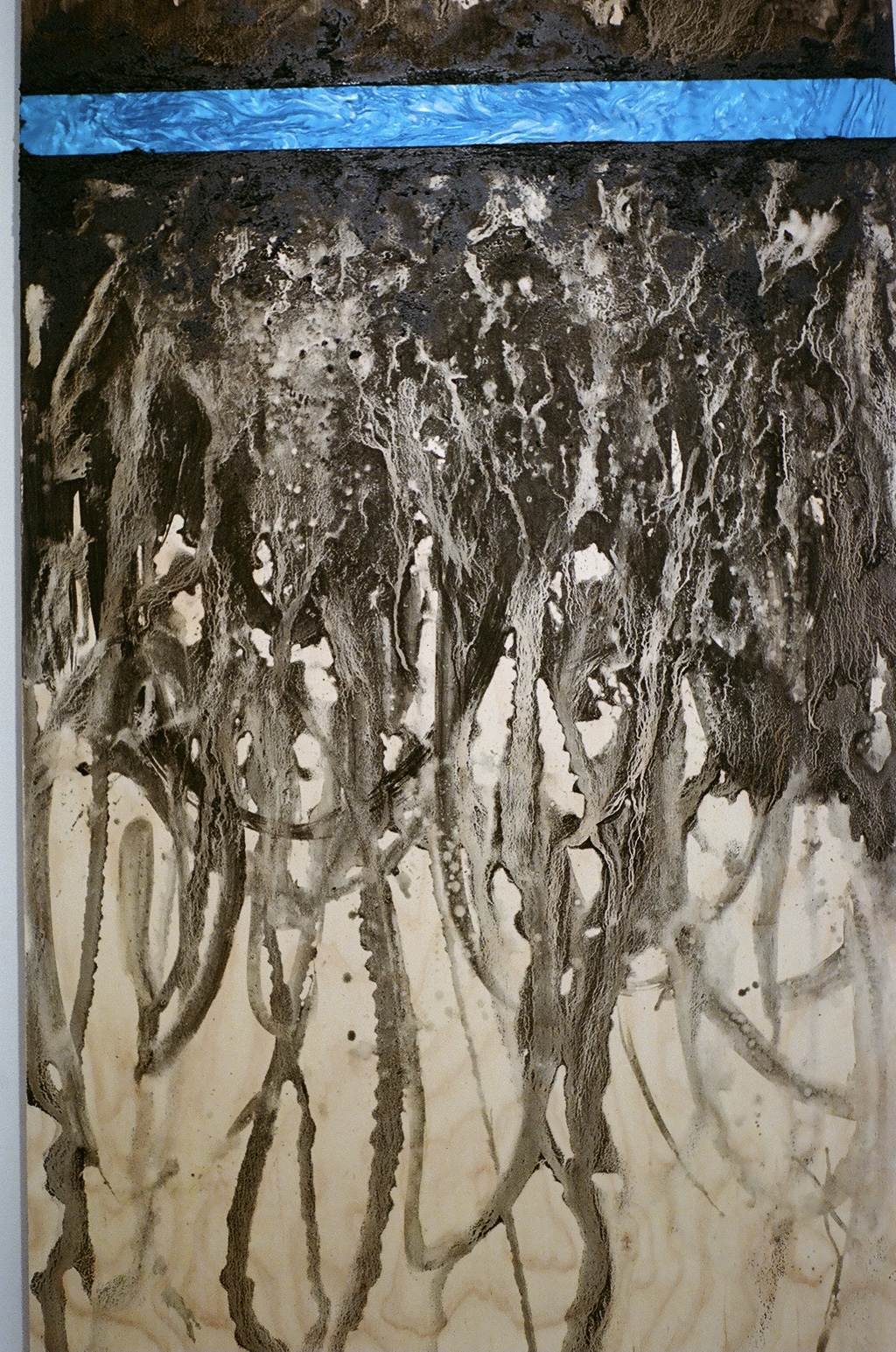
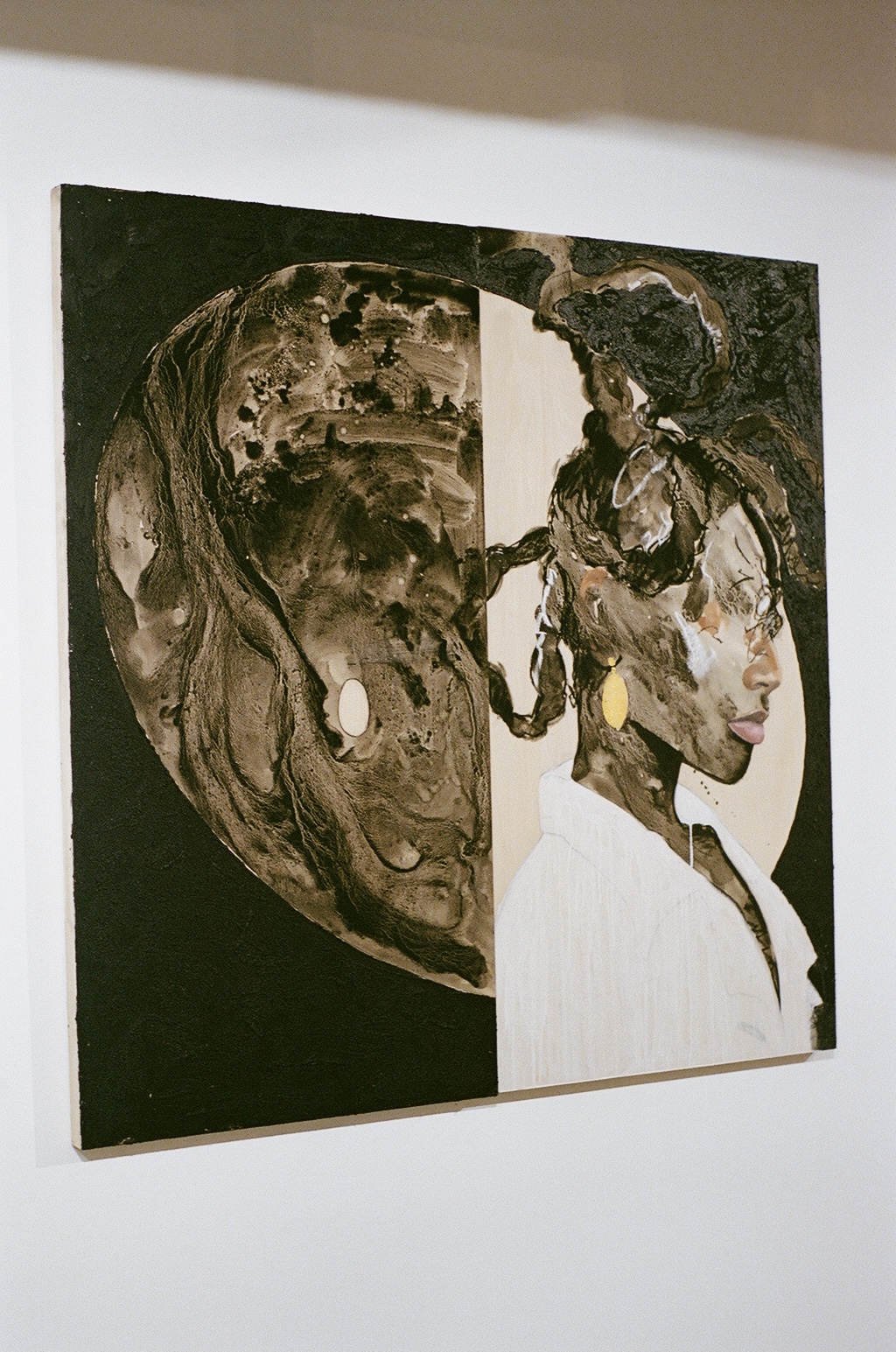
Your mom mentioned to me that your uncle was an artist, or was he your grandfather?
It was my uncle, but it was also my grandfather. So my grandfather was the one who got me interested in art. Not on his own fruition, he just did drawings and stuff, and I wanted to do what he was doing. My uncle who I never met was an artist, or at least they tell me he was, I guess he was really, really good, but he died before I was born. But my grandfather drew all the time and he also did woodwork and stuff. So I would see him making things and drawing and I wanted to learn how to do that. So I would have him draw something and then I would try to replicate it in one way or another.
That was the first thing you had that resonated with you? Your mom said you would draw with crayons all over the house.
It was more that he was an outstanding man, just as a person. He did all the things that he was supposed to do. He was never loud or angry. He was always like attentive and very much into what he was doing. Drawing was his focus, his attentiveness and his encouragement of like, “Now you try, it”, was always something that stuck with me. Because I would always want to be that type of person where I could do something and I'll show you how to do it, but I'll also let you do your own thing. So him doing that, it made me really confident. The problem is I don't remember none of those things that happened when I was younger, actually got into an accident when I was 14 and shook my whole head. I have barely any of those memories.
Well Harry Potter also got the scar. For me, I never knew about artists growing up in a suburb and it wasn't until I moved to San Diego and met Shepard Fairey. What I really, really love and appreciate is the amount of ways that you are creating these paintings from the textures to the abstractions, to the colors, charcoal, just the whole thing feels like the spirit of what you're doing is there. It's also this kind of metaphysical magic when I'm seeing in the paintings. And so sometimes there's this master and apprenticeship that happens.
That's why I brought up Kehinde, right? It's very much in the room. I was here and I was so proud that a great master that's peaked and very respected came in here with his dog and just timing wise, he ended up being in here. I feel like the kind of telepathy of what painting and fine art represents kind of put you and him in your show. It was this beautiful moment and there was this photo taken. I think that great artists and people that have great ideas and could possibly be contributors to the legacy and the passing of the torch of what fine art and artifacts and what past masters have done for us as being, because I know that you probably have a couple of handfuls of past masters. You already brought up Ellsworth Kelly and Cy Twombly, Frank Stella.
Kehinde Wiley
Oh, definitely but you are your own beast. A woman {unintelligible name} said to me, “you may need protective ambiance and energies to internalize the world as it comes to you”. And I feel like in your work the spirit of a bunch of past masters, deceased masters and living artists are all channeling and you are kind of a custodian or a conduit for that.
Yeah. That's what I'm hoping for. That's what I'm working towards, thinking about all these different people as I make this work that's like a mix of abstract and configuration.
Maybe through artists telepathy and like that metaphysical energy that creates the physical object. Maybe you are actually a part of that narrative and that dialogue. In that way, its very much like the Avengers or the X-Men or like a Harry Potter thing where there's these people that when they're younger, have this kind of misunderstood, confused magic, and then something comes and recognize it, and then they go to an institution with others and learn how to tame the magic. Do you think as a contemporary artist that it's important to understand the idea of that none of us is greater than all of us?
Of course.
Are you aware that you have been chosen to be kind of an entertaining force in the contemporary art world?
I don't think so. Not yet. I think I'm on the outside witnessing a dance battle. I see people in an arena, going at it and I'm on the edge, ready to go at it.
Artists going at it or collectors?
When I say dance battle, I mean showing up with respect to each other, not in a way where one's trying to dominate the other, but I feel like there's so many other artists out there who are already kind of—
Well how old are you?
Thirty.
Yeah. You're still a baby. What about being involved with auctions and watching the value of your work go up? How does that affect the work?
I don't think that affects the work as much as it does for other people. That, for me, isn't anything. I see it as like another part of this land to working as an artist in New York City. One way or another, but I think the auction is one of those things where — its really interesting to take part of and be part of, it was just like seeing what my relationship to my work is to what everybody else's relationship to it.
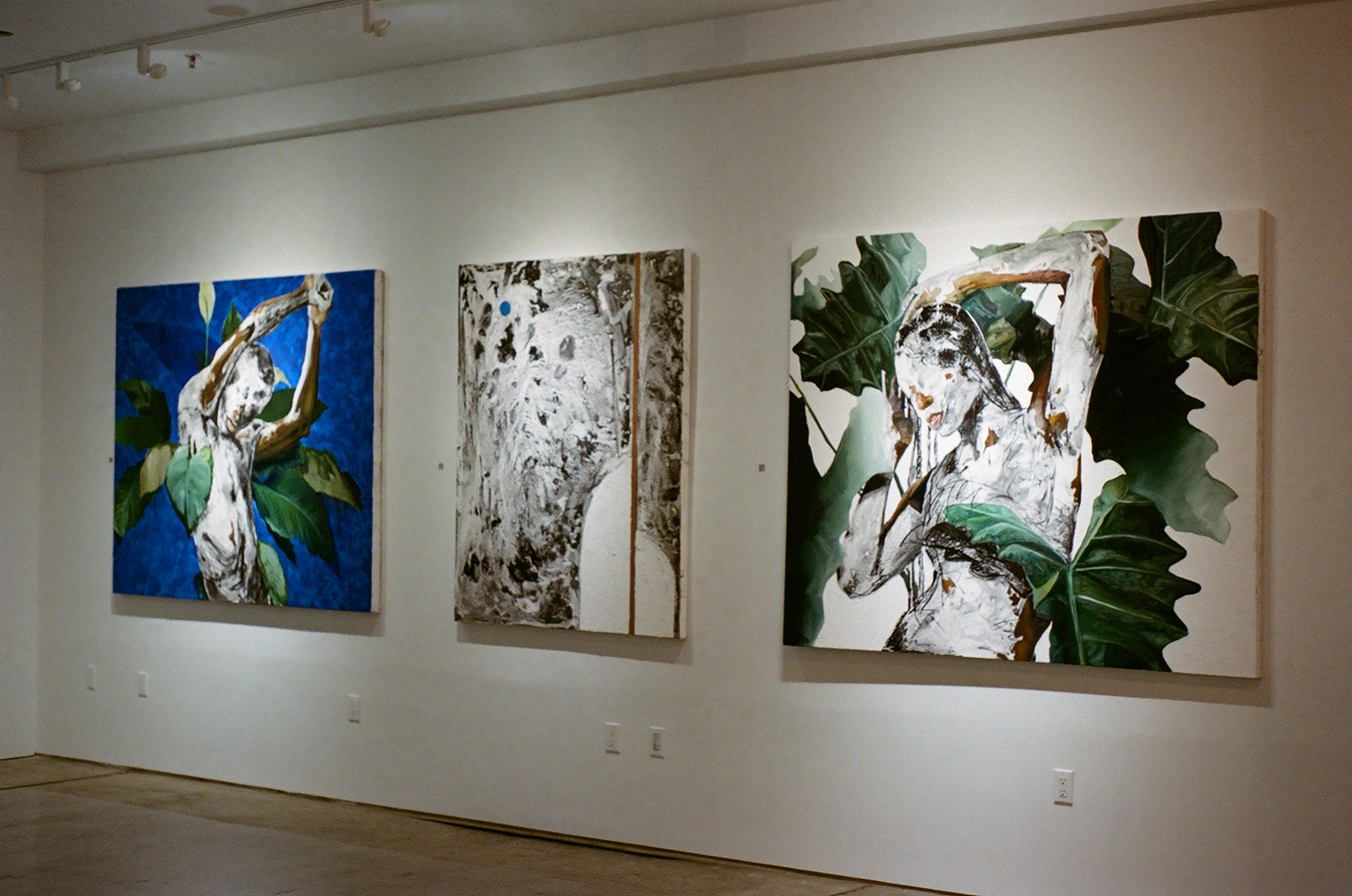
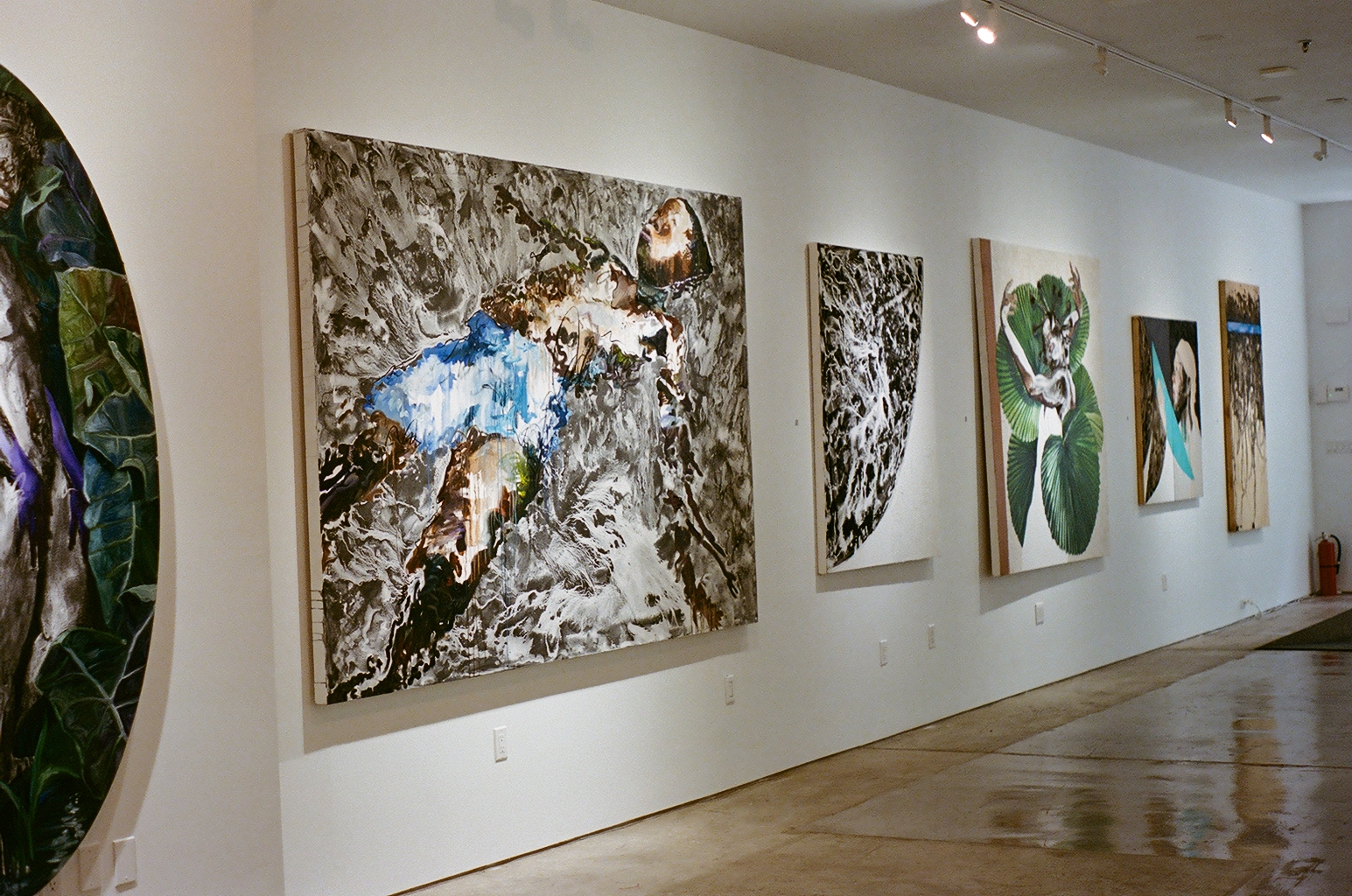
Well, the relationship possibly with collectors is that they want to invest and watch the stock grow and become. I think that when your work is being collected they are telling you and showing you that they believe in you.
Yeah. I believe that very much. I think that that's also like one of those things where I didn't know anything about collectors until I got here. I knew people bought art, but I didn't think of it being as much as it is. I didn’t think of it as something being a new or young Tate modern type of thing where, you know, eventually their collection will be in a museum.
You think people would just want to decorate their houses?
Well, not even that, I think that I just felt like they wanted to be a part of history and one way or another, but not in a different type of way that, ‘like I'm collecting these as artifacts to put in something else.’ I still think that collectors and collections are foreign to me in a lot of different ways. Because I’m in it and I'm in some of these collections, but I also don’t know the magnitude of what it means to be in these places just yet.
Let’s talk about, um, we both have shown with Destinee, right. And when I had show with Destinee, I very much was honored to be given the privilege to be under her brand or under her umbrella. How important is it and how much attention are you giving to who you're actually allowing to exhibit and protect and create the market and place your paintings?
A lot more than I had given at first. At First what I was really interested in, was just showing the work because obviously there's a lot of people who tell you that getting into art collections or getting in with anybody is really, really hard for artists and I didn't experience that. So it was foreign already because I was like, ‘okay, well, if it's really, really hard, then I'm gonna just show any and everywhere.’
But now it's going to become site-specific?
Exactly. Yeah. So right now I'm in a position where I'm really concerning myself with who's showing the art, who's collecting the art, and where is it going? Because I know now that those are important, but also those things tend to create a conversation about myself about what's the next thing that's gonna happen?
The two or three people that are to your left and your right are reflections of yourself.
Exactly. As well as where I am and where I'm at, it's also a reflection of where potentially I can be going.
You're going to go far, Khari.
I appreciate it.
I'm a little older, you know, so I've seen a lot of careers peak and flourish and I have a lot of friends and acquaintances. They're great artists and I really love observing the process of different contributors to contemporary fine art. You know, Joe Bradley also Robert Nava. As far as Destinee Ross-Sutton and her attention and respect that she's getting and how much support she's getting from patrons and collectors, how much of that relationship do you see as something that is equally beneficial for the two of you?
Oh, very much. I tell Destinee this all the time, if she ever needs anything, I'm always there. It's one of those things where I try to make it easy for her to work with me as much as I want for us to work with each other really easily. And it's always been like that even in certain things, because there's a lot of times where I was just happy to be making art and I was do my own thing and she would just offer me up an opportunity. And a lot of the times it might've been like a shorter opportunity or just a sudden opportunity, but I was already ready.
I think that she's young and that her career is also very fresh and has a good longevity and process, as long as she keeps it interesting. My friend Brian Belott and I were joking about this the other day. He's a great artist. He showed with Gavin brown, Canada and stuff like that but he's kind of comedic. Sometimes he jokes around that once an artist’s paintings are being desired by collectors, people know that they're looking at money. Right now we're looking at great paintings. You're definitely a great painter, but at some point it will switch and people know that these great paintings are looking at money. I asked him about one of our mutual friends and jokingly he was like, ‘oh yeah, when I ran into so-and-so they said they were going to the studio.’ And Brian said, oh, you're going to work on your brand.
What's important for myself and what keeps it interesting for me is once you have your moment on Broadway and your name is out there and people are excited about your work, I think it's our job to keep the mysterious and keep the one or two times a year when you have an opportunity to exhibit, keep it protected and secret until it hits the sterile gallery space and keep it interesting. I had this thought for you. Would you ever think about directing a performance video? Is that something you think about or is it strictly, Khari Turner, two dimensional paintings, because the paintings are seemingly also three dimensional. So do you think about actual three-dimensional objects that hold space on the floor?
Yeah. Well, I'm a sculptor. So in thinking about sculpture is the reason that I also think of the way that these paintings function. Because sculpture is so much about material where as painting is so much about what you're looking at visually and how the manifestation of two dimensions either changes in two dimensions or does not change from two dimensions to three dimensions. So I'm actually thinking about material constantly because of sculpture. As far as performance goes, I'm already underway.
You are? That’s exciting.
Yeah. Because the thing about it is with this work, I know that there's a way to create multiple means of talking about the art.
Creating more opportunities for people to experience memories through your language.
Exactly.
I love that.
Yeah. I'm trying to make it, so it's like a whole experience, the paintings are the painting, and the skills like great. But if I was to take this one painting and make it into an entire room, how does that feel? And so I need to know these answers as well as visuals that I can only get with just this, that I can't get in other places. And so I need to know these answers. I also I feel like there's a lot of visuals that, you know, I can only get with just this, that I can't get in other places.
Yeah. I was thinking of in 2019 you know there's the amazing program in the Hamptons that, Robert Wilson started, it's called the Watermill and it's a sculpture and performance. And there was a dancer, a crunk dancer, super powerful, and I had been following this guy on Instagram and all of a sudden he was like one of the main performers at the gala. He was super built, like a warrior. When I'm in this room I feel like there's a tribe thing happening in here. I feel like I'm witnessing— the paintings are giving me a ceremonial vibe, like a bathing, and a cleansing, and a kind of purification. I feel like wherever these paintings are coming from, there's this ancient and very modern feeling. I see them as being something that is ancient, but very present and very much in the future. Right?
Yeah. And that's exactly what I'm going for with them in one way or another. Because they're made out of water and because they have no faces, then they become kind of celestial in one way or another. And because of the way the water looks, sometimes it looks like a moon on some of these rounders surfaces. So there's different parts of this, because it's made from earth and multiple pieces of art put together it's kind of like building something out of ceramic.
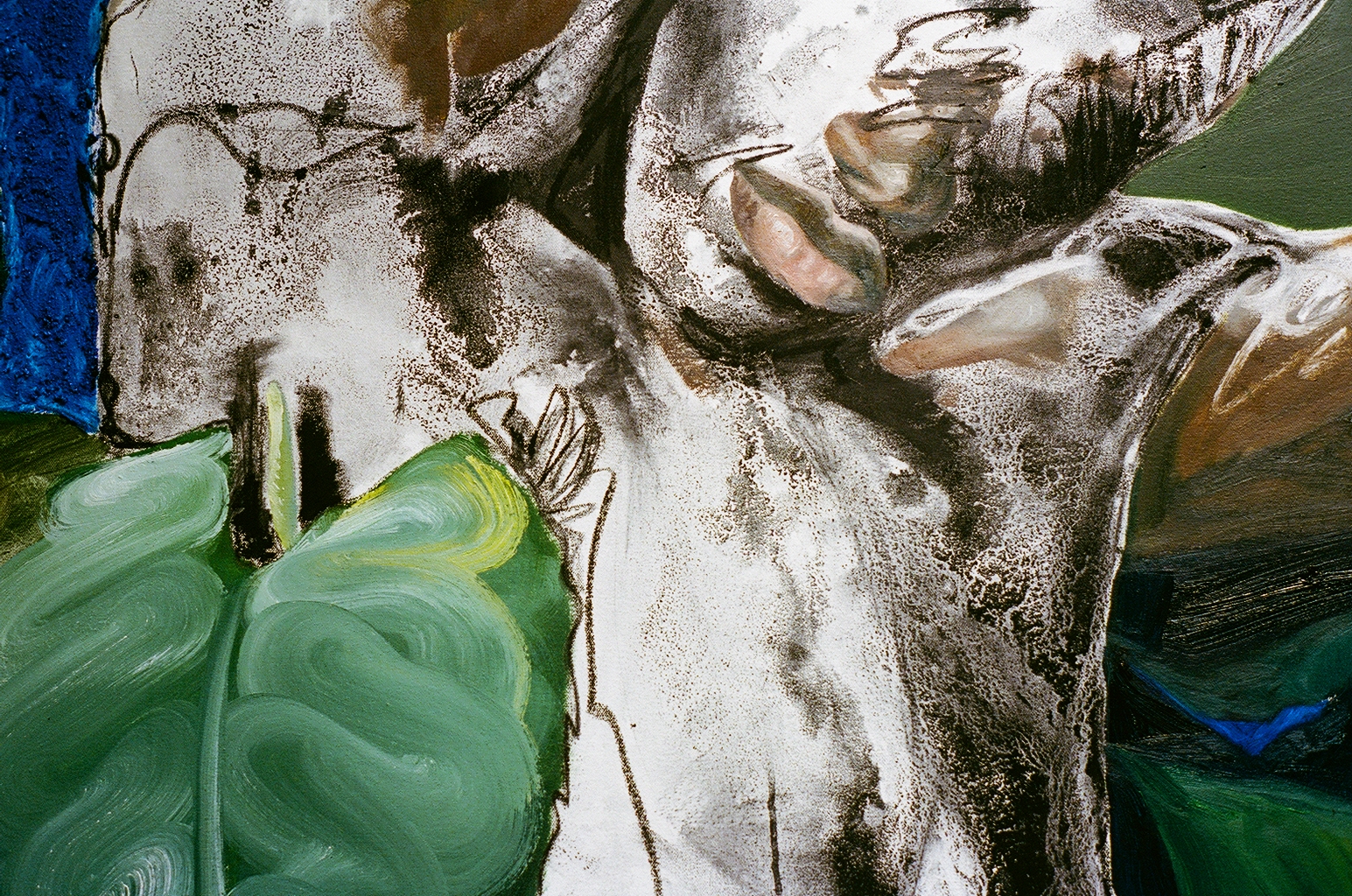
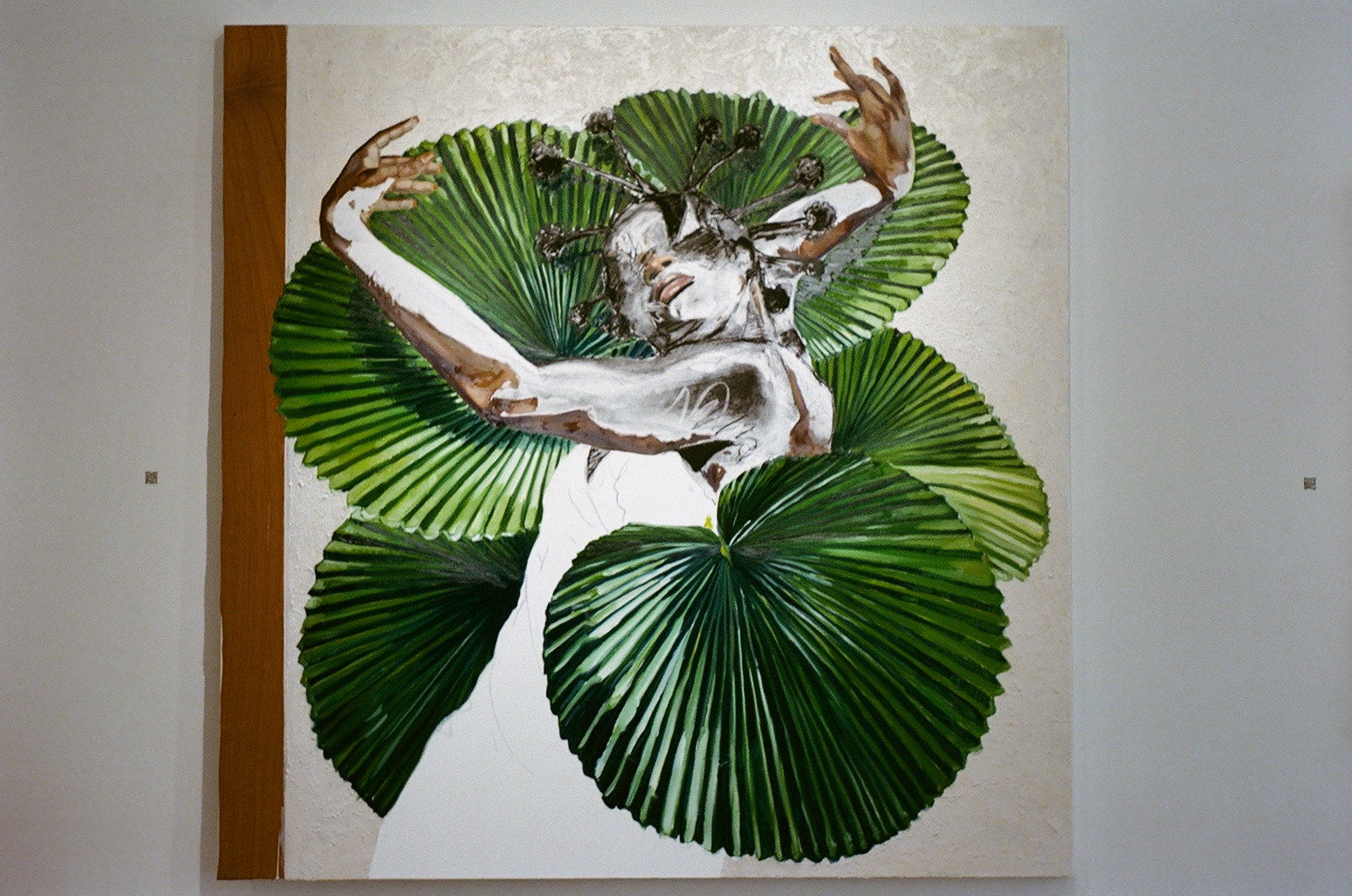
Let me ask you this question too, because when I first met Destinee we were allowed this space, and the first thing I thought of when I met her, was, ‘oh, you are being recognized for curating the biggest African-American group show at Christie’s.' Right, and the first thing I thought of was that, possibly you don't want to get pigeonholed into just being someone that is recognizing the gift and the talent and the contributions that only African-Americans, or the black race have, right. So I was like, I would love to do a show with you, and so I specifically made the paintings with her in mind and in the energy of that. But for yourself, being a very recognized, very fresh, and young, and respected archetype for your own individual contribution, and you being allowed to create your own language and, be given that respect, how important is it for you to have dialogue with people that aren't necessarily African-American like other painters?
Oh, very important. Honestly, when I talk about the work, I'm talking about the extraction and as the conversation between those people. So I see the abstraction as an immediate conversation with those people, and how to address people who are not African-American or black, looking at the work in one way or another.
Do you think that that being African-American helped you get to this point?
Uh, no. I think what it did is make me evaluate life in a different tone, in a different way. I think that everybody always has their own kind of problems in one way or another and they make their art in that way. I think that what is important is understanding where I am and how I want to function in the space of just living, especially in the United States. Being, African-American also makes it really hard to be the type of artists that I want to be, cause then essentially—
Me too, I'm also a minority, you know?
Yeah. Well with being a minority, the biggest thing about being a minority is that people always instinctively look at your work through your minority. So if I was to make just straight abstractions and have nothing to do with any type of history, as far as being African-American or black people would already put a lens on that work as going through that blackness.
I will say that from my observation, I think you nail it with figurative, but I think when I think of even my own lineage and ancestry and what I'm connected to in my own spirits or whatever, I think that you are respected and being paid attention to, and, I think it'd be amazing if you dissected the surface and just did pure abstraction. I feel like the difference between painting a narrative and a figure or some little motif as opposed to abstraction. I think that when we go to make abstract marks as painters, I feel like it's very much, paying homage and respect to the different tempos and kind of sounds of mark making.
Like if you and Rashid Johnson had large scale ,seven by eight foot canvases, and both of you just prime the background one color and just went for it with mark making. I feel like I would really, really like love to see the, the kind of the aggression and the, and the softness of your touch. And why I think that people don't see the softness of this, and they don't see like the kind of beautiful moment this is having. You know what I'm saying?
I think it depends on the people. I feel like some people definitely see it right away, and then others have to discover it.
Do you have a, do you think that you would do your audience, that kind of gift to let them see you just make the marks instead of like having to figure present?
Oh, well that's next!
Oh, that’s exciting. Because remember, I showed you Joan Mitchell.
Yeah! After you said that I really started looking at that.
You know got it got weird for me because I don't know if you think that someone that loves art as much as we do— there's always this certain thing where like you interact with humans and then, you know, I personally, and I'm being super genuine and sincere when I say this, I get excited when I see someone like yourself, because I know that this isn't cynical. Do you understand what I'm saying? This isn't like, I trolled Instagram and looked at some abstract equations and decided to copy some marks or some motifs, or some figures, do you understand what I'm saying? So when I met you, I just saw what Destinee had.
And I didn't know, because we've never met or we've never had a dialogue. I didn't really know how you were taking the rambling or the purging of how energetic I was about your work, you know what I mean? Because at the end of the day, you know, like, even with Julian Schnabel's movie about van Gogh, it was van Gogh and his buddy. Right. And then there was Basquiat and Warhol, you know? And I went to art school, got a BFA, but it was like Donald Bachelor and Lance and I observed Donald bachelor. So I just wanted to know, being in the position that you're in from time to time, is that like something that you think is important to merge with other artists and have those conversations and get excited about each other's magic that's happening in the studio and what they're creating?
Oh, all the time. I did it a lot through this phase, but also through Instagram and one way or another, and then branching out from there. When you were talking to me, I always make sure to think about quieting myself inside so that I can really listen. And so when you were talking and you, you were energetic, I really felt like I was making sure that I was hearing everything. It's really important for me because I know that when there's energy being presented, that I want whatever that is. And so feeling it, I was like, okay, what am I hearing? What am I listening to? What am I really interested in? Then the things you were talking about, especially with Joan Mitchell and the circles, and drawing in the space, I was really excited about.
But also this, remember we brought up Daniel Turner. That's crazy, literally Daniel Turner that is Rita Ackermann’s partner, when he did the first show at the journal, when they opened up their huge space in Williamsburg and he made a stain, but it went the whole length of the wall. When I went in there, I was like, I feel like you lifted, Richard Serra sculpture out of the space and that's the stain. And I feel like that stain under that painting is very much some connection with your work in the space and like this kind of a conceptual art piece, right?
Yeah, and it's so funny because it's one of those things where the work does itself, does its own thing, and the work has its own spirit, and I kind of just work with whatever that spirit gives me. um,
By talking to you, there’s also this kind of like innocence and vulnerable strength that you give off, that your personality gives off, you're very humble. Right? Do you feel like that?
So, when I grew up, it was me, my sister and my mom. My dad split, don't know where he's at, never met him. My sister has a disability, not anything physical.
The one that I met?
No, my older sister, my other two siblings came after. So I'm 30. The oldest of them, or my sister is 17. So there was a giant gap between the two of us, but I have another sister who's a year and a half younger than me and she has a mental disability and another other disability from her side of the family. But either way, what I'm bringing up her for is because she had that going on and essentially I recognize that at a young age and what that made me do was realized that I needed to be patient. I also needed to have an understanding of life differently because the attention that the family needed to give her because of her issues had nothing to do with me. I also needed to be the one to be in this position to whenever I needed to.
Khari I’m being honest with you, I definitely think that you are going to take care of a lot of people through your art career.
I’m trying to, for sure. I think it's one of those things from growing up in that way, I really got to understand that, you know, nothing is ever about me. It's so much about the collective. It's also about being able to be patient. Listening is always important to me, especially when other people talk because there's times where she would say stuff and it would not make sense, but at the same time that if you really paid attention to what she was saying, she would tell you if she had pain or if she was happy. Being able to listen to someone is very important.
Well, what I think, from someone that's lived here for awhile and like really cares about our city and being an artist and what it means to be an artist, and the responsibilities, I think that a lot of people that you can't see really care about what you bring to the table. I think that you are protected know, and I think that it's so beautiful to see the early stages of your career. I think that being hyper aware or just being in my head so much and kind of articulating or analyzing all of the different players, I think that it's important for us as the actors and the artists to just stay in our position and make the work and just trust and have faith that everyone else is going to do their job as long as we do our job.
Very much so. I think that's the great thing about working with Destinee is I know for a fact that she knows that I'm gonna do my job, and so she works really hard to do hers in one way or another.
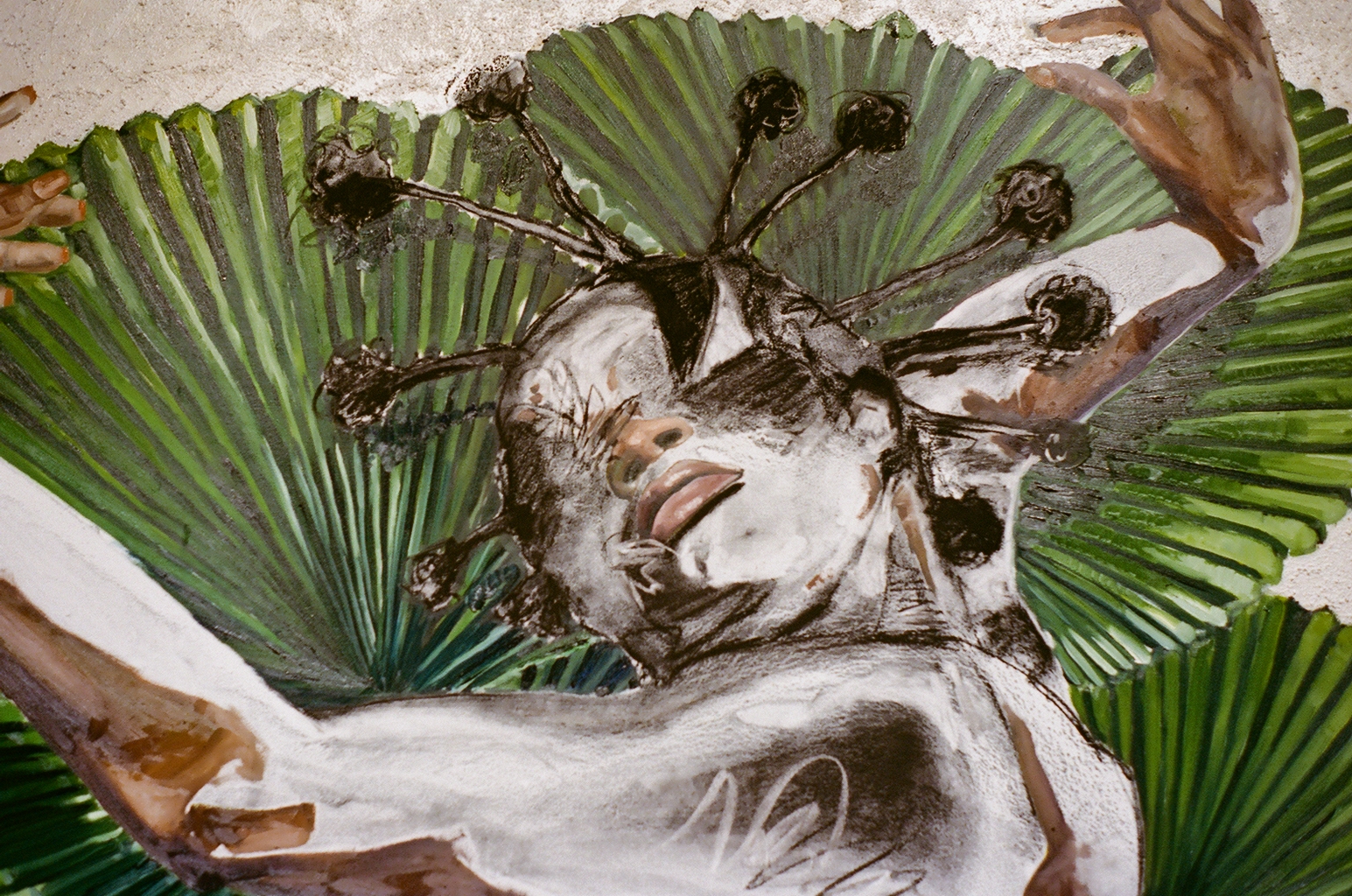
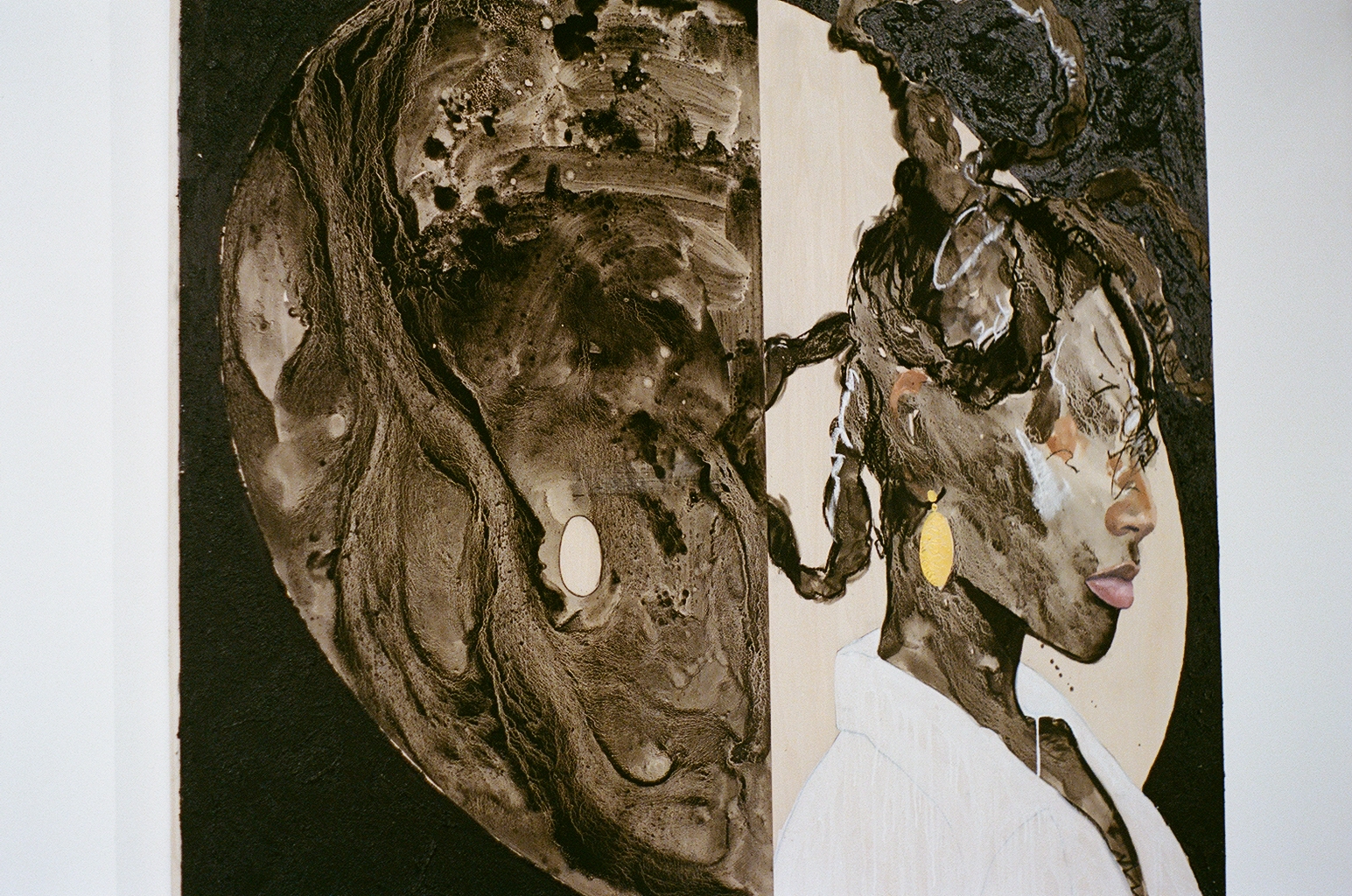
Yeah. She actually, you are the most powerful artist that she is I'm responsible for right now, and I think that, just like when we're making the paintings or making the art or experiencing these ideas you can't necessarily always see everything, right? You kind of sense it, right. So what I really am excited to tell you is that I think that other great artists and people that know that have came before us, like Kehinde Wiley, like, Rashid Johnson, are very proud of you. Do you understand what I'm saying?
It's a certain thing where, you know, we all have our families, right, but I think that in the contemporary art world and in the art world in general, you actually get initiated into this bigger thing. It's amazing to see you subduing yourself and putting your heart into the work.
Oh yeah. Yeah, for sure. You know, at the end of the day, that always comes first. And I think that making it first is always the best option.
Can you give me like a little bit of an explanation of what you said see for the future, or are you just like totally in the moment?
It’s both, in one way or another. So I am really excited for the future because I feel like now that I'm out of school and because I'm now in a space where the work is kind of doing multiple different things, that is going to be really interesting for me to take the reins of allowing every single minute of my time to be a part of the process. Whereas with school, I had to worry about classes and work and papers and all that stuff. Now I have to worry the emails I get for this. My next set is to, to travel, go to different places, see different waters experience, different things, but then also figure out how I'm gonna start learning to give back and one way or another.
You want to do charity, right?
Yeah. I wanna figure it out. There's so many people who don't have good water and that's a problem. You know, we can always ask politicians and big corporations to do stuff, but a lot of them are not going to do anything. If I can at least get some money from selling these paintings, I can put that money towards helping people in one way or another. That's the, right under art, giving back in one way or another, that’s the second most important thing to me. That's going to be the next big thing.
Getting this together, you know, working on abstraction, working on these videos, working on some sculpture pieces. I'm like really interested in those, but then after that, all that work and traveling and trying to get this to really functioning in one way or another, giving back is what I want to do.
If I grew up with somebody around me in the area that I lived in, I probably could have maybe gotten here faster, and maybe I could have experienced something different, but knowing that I came from an area where I wouldn't have been afforded this opportunity unless I like worked myself out of it, seems like I need to get in where people don't need to work out of anything. They just need to be ready to work. That's important because I feel like, you know, you shouldn't have, shouldn't have a hard time getting out of a situation, you should more time trying to be something that you want to be. So that’s the next thing.
When I heard you saying that, that is the mindset, and the obligation, and the mission of a true king. You know, to realize that you have the recognition. And of course, you know, people think about money and abundance, but you're actually going to create an empire with these paintings and you're gonna serve and take care of your empire.
Yeah. I think that, that's what I got from my grandfather. He was one of those people who didn't do a lot of things, but he did exactly what he knew he needed to do to get his family to be good. So that's what made me so interested in him is because people would go to him for things, and he wouldn't say no to those people he just be like, I can do this for you. It might not be exactly what they needed, but he would teach a man to fish. You know what I'm saying? He wouldn't be the one that would get you a fish. I think that the teaching to fish is the most important, you know, cause it's that saying, ‘ you can give a man a fish, he’ll eat for a day, if you teach a man to fish he’ll eat for a lifetime.’ So I think the lifetime is the most important part.
That's beautiful, Khari. So there's a lot that goes in to Khari Turner.
Yeah!
Yeah. We're not just looking at the great paintings, we're also looking at Khari Turner the great idea. I get tripped up because some people are like, I'm living the dream, but then when you dream, you kind of gotta wake up. So I think Khari Turner, has a vision and the paintings and the artwork are just clues that the vision is very relevant and achieving its goals. Right?
Yeah. I never mentioned it as a dream, it's always been an ambition. Cause I feel like dreams, you have to wake up, but also dreams aren't real either.
No, you have a vision.
Yeah.
All right, great. Well, Khari, I just want to say thank you for your time. You know, I'm very proud to meet you at this stage, for this chapter, and I'm very honored that you allowed me to speak with you and share a little bit about what's happening with yourself and the paintings.
Thank you for having me and thank you for being a part of this and allowing me to speak.
I mean yeah, you got a lot of press, but I think like hearing your voice, you know, I was trying to see if we could do a video, but, office they're doing podcasts. So the photographer came in and took photos, so we'll do that, and then we'll see if the POV and the interview is good, but this was, this is very, instrumental. So thank you again, Khari.
